‘Why? Why? Why?’ Ukraine’s Mariupol descends into despair
MARIUPOL, Ukraine (AP) — The bodies of the children all lie here, dumped into this narrow trench hastily dug into the frozen earth of Mariupol to the constant drumbeat of shelling.
There’s 18-month-old Kirill, whose shrapnel wound to the head proved too much for his little toddler’s body. There’s 16-year-old Iliya, whose legs were blown up in an explosion during a soccer game at a school field. There’s the girl no older than 6 who wore the pajamas with cartoon unicorns, among the first of Mariupol’s children to die from a Russian shell.
They are stacked together with dozens of others in this mass grave on the outskirts of the city. A man covered in a bright blue tarp, weighed down by stones at the crumbling curb. A woman wrapped in a red and gold bedsheet, her legs neatly bound at the ankles with a scrap of white fabric. Workers toss the bodies in as fast as they can, because the less time they spend in the open, the better their own chances of survival.
“The only thing (I want) is for this to be finished,” raged worker Volodymyr Bykovskyi, pulling crinkling black body bags from a truck. “Damn them all, those people who started this!”
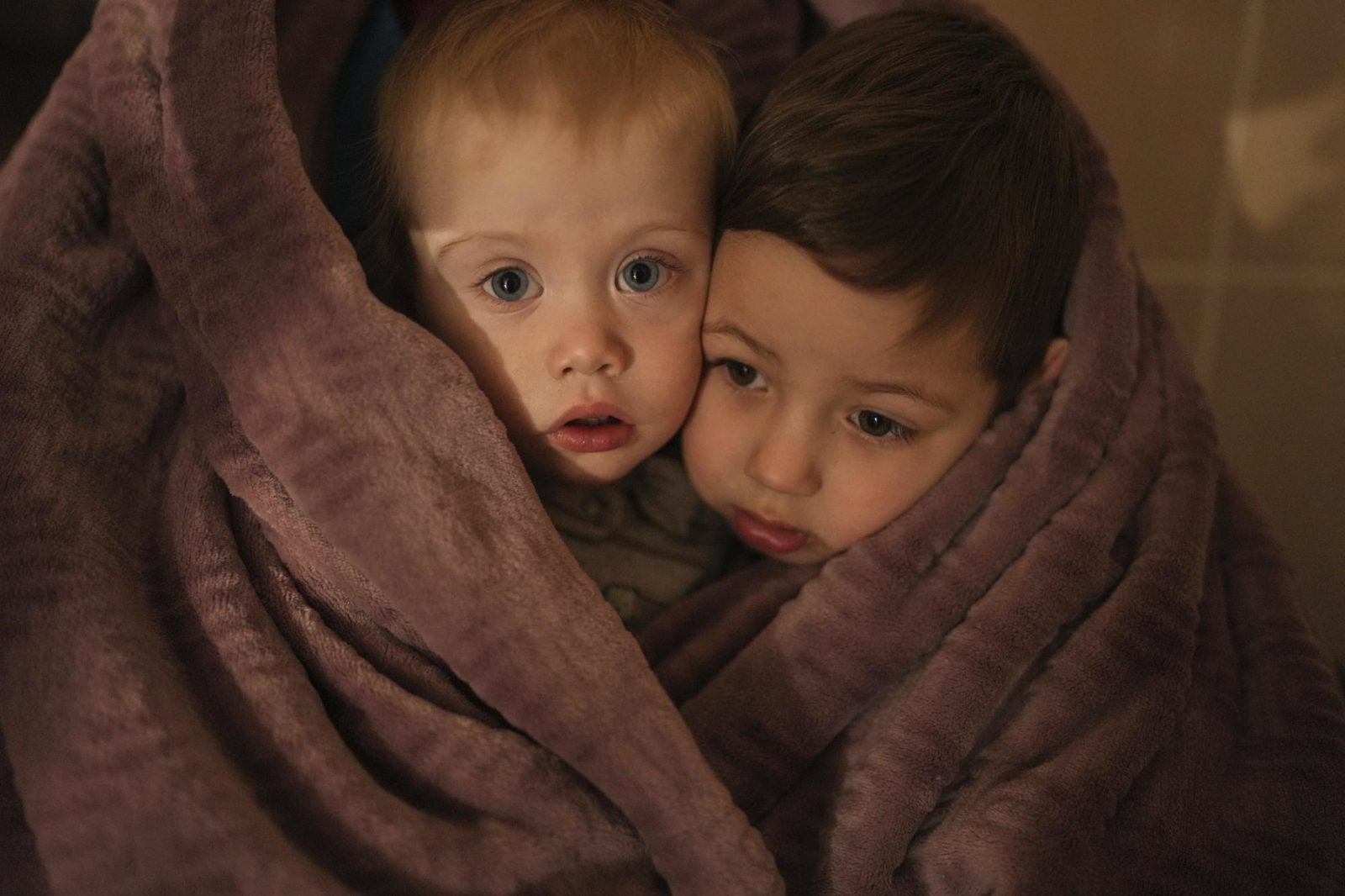
The children of medical workers warm themselves in a blanket as they wait for their relatives in a hospital in Mariupol, Ukraine, March 4, 2022. (AP Photo/Evgeniy Maloletka)
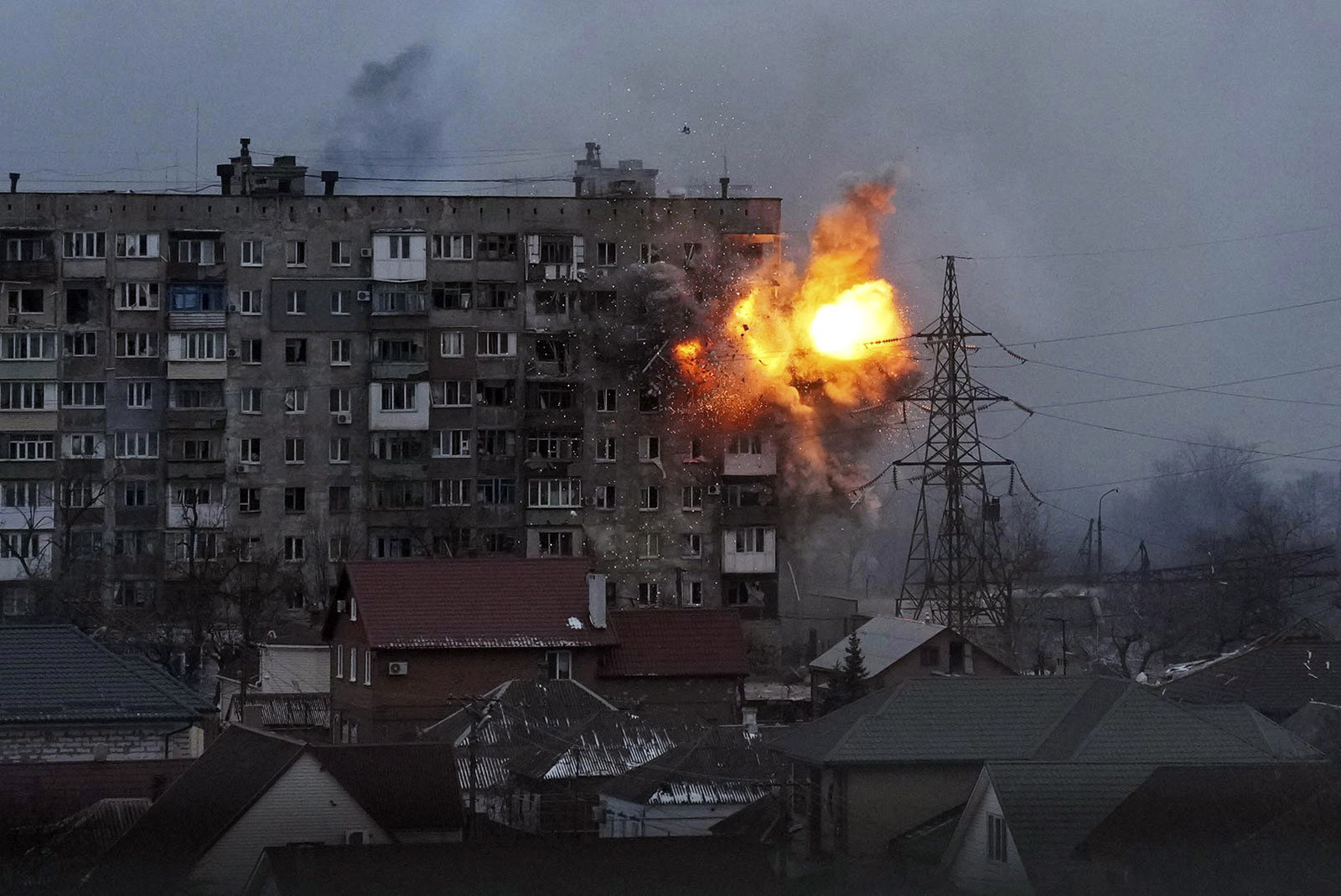
An apartment building explodes after a Russian army tank fires in Mariupol, Ukraine, Friday, March 11, 2022. (AP Photo/Evgeniy Maloletka)
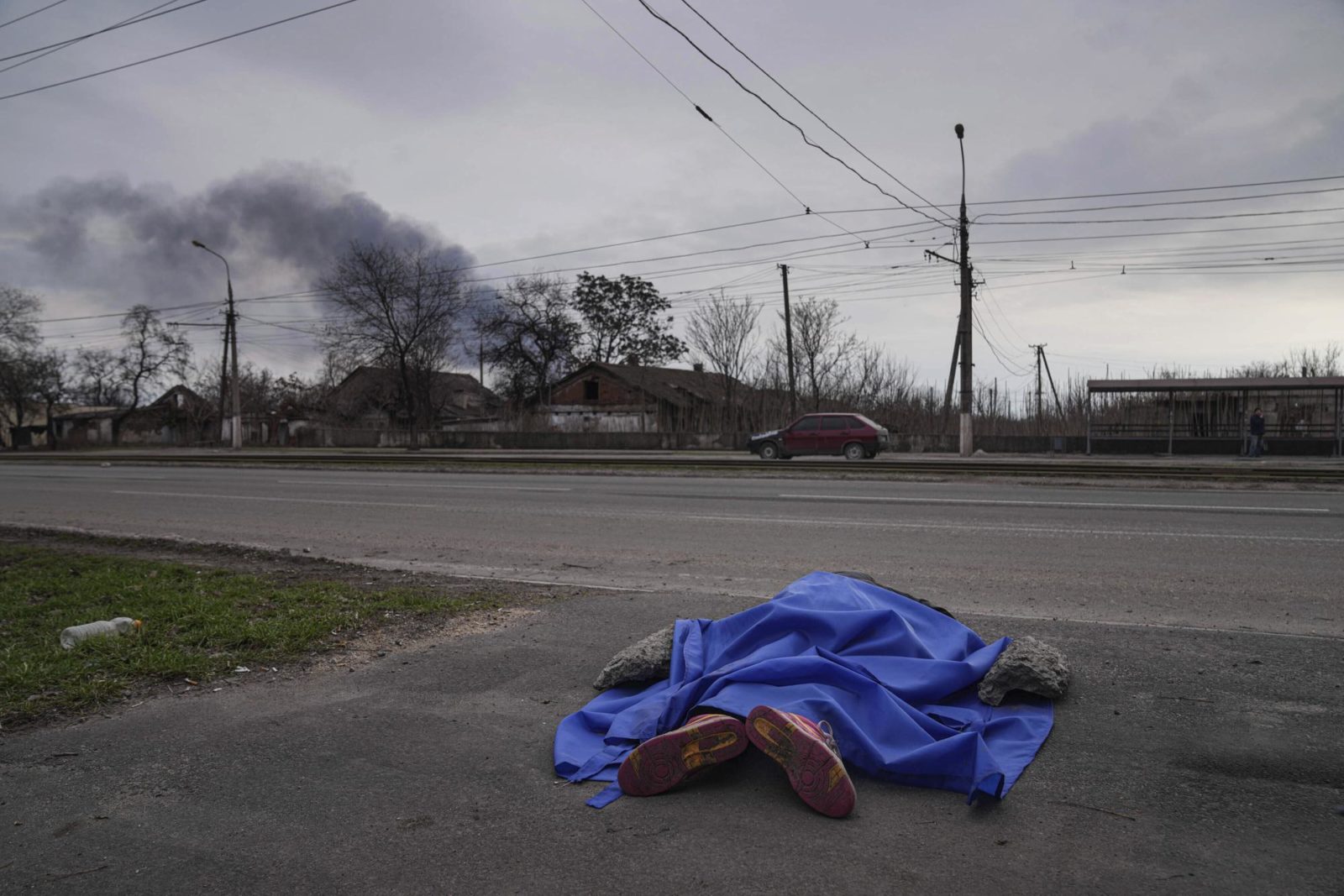
A body lies covered by a tarp in the street in Mariupol, Ukraine, March 7, 2022. (AP Photo/Evgeniy Maloletka)
More bodies will come, from streets where they are everywhere and from the hospital basement where adults and children are laid out awaiting someone to pick them up. The youngest still has an umbilical stump attached.
Each airstrike and shell that relentlessly pounds Mariupol — about one a minute at times — drives home the curse of a geography that has put the city squarely in the path of Russia’s domination of Ukraine. This southern seaport of 430,000 has become a symbol of Russian President Vladimir Putin’s drive to crush democratic Ukraine — but also of a fierce resistance on the ground.
In the nearly three weeks since Russia’s war began, two Associated Press journalists have been the only international media present in Mariupol, chronicling its fall into chaos and despair. The city is now encircled by Russian soldiers, who are slowly squeezing the life out of it, one blast at a time.
Several appeals for humanitarian corridors to evacuate civilians went unheeded, until Ukrainian officials said Wednesday that about 30,000 people had fled in convoys of cars. Airstrikes and shells have hit the maternity hospital, the fire department, homes, a church, a field outside a school. For the estimated hundreds of thousands who remain, there is quite simply nowhere to go.
The surrounding roads are mined and the port blocked. Food is running out, and the Russians have stopped humanitarian attempts to bring it in. Electricity is mostly gone and water is sparse, with residents melting snow to drink. Some parents have even left their newborns at the hospital, perhaps hoping to give them a chance at life in the one place with decent electricity and water.
People burn scraps of furniture in makeshift grills to warm their hands in the freezing cold and cook what little food there still is. The grills themselves are built with the one thing in plentiful supply: bricks and shards of metal scattered in the streets from destroyed buildings.
Death is everywhere. Local officials have tallied more than 2,500 deaths in the siege, but many bodies can’t be counted because of the endless shelling. They have told families to leave their dead outside in the streets because it’s too dangerous to hold funerals.
Many of the deaths documented by the AP were of children and mothers, despite Russia’s claims that civilians haven’t been attacked.
“They have a clear order to hold Mariupol hostage, to mock it, to constantly bomb and shell it,” Ukrainian President Volodymyr Zelenskyy said on March 10.
Just weeks ago, Mariupol’s future seemed much brighter.
If geography drives a city’s destiny, Mariupol was on the path to success, with its thriving iron and steel plants, a deep-water port and high global demand for both. Even the dark weeks of 2014, when the city nearly fell to Russia-backed separatists in vicious street battles, were fading into memory.
And so the first few days of the invasion had a perverse familiarity for many residents. About 100,000 people left at that time while they still could, according to Serhiy Orlov, the deputy mayor. But most stayed put, figuring they could wait out whatever came next or eventually make their way west like so many others.
“I felt more fear in 2014, I don’t feel the same panic now,” Anna Efimova said as she shopped for supplies at a market on Feb. 24. “There is no panic. There’s nowhere to run, where can we run?”
That same day, a Ukrainian military radar and airfield were among the first targets of Russian artillery. Shelling and airstrikes could and did come at any moment, and people spent most of their time in shelters. Life was hardly normal, but it was livable.
By Feb. 27, that started to change, as an ambulance raced into a city hospital carrying a small motionless girl, not yet 6. Her brown hair was pulled back off her pale face with a rubber band, and her pajama pants were bloodied by Russian shelling.
Her wounded father came with her, his head bandaged. Her mother stood outside the ambulance, weeping.
As the doctors and nurses huddled around her, one gave her an injection. Another shocked her with a defibrillator. A doctor in blue scrubs, pumping oxygen into her, looked straight into the camera of an AP journalist allowed inside and cursed.
“Show this to Putin,” he stormed with expletive-laced fury. “The eyes of this child and crying doctors.”
They couldn’t save her. Doctors covered the tiny body with her pink striped jacket and gently closed her eyes. She now rests in the mass grave.
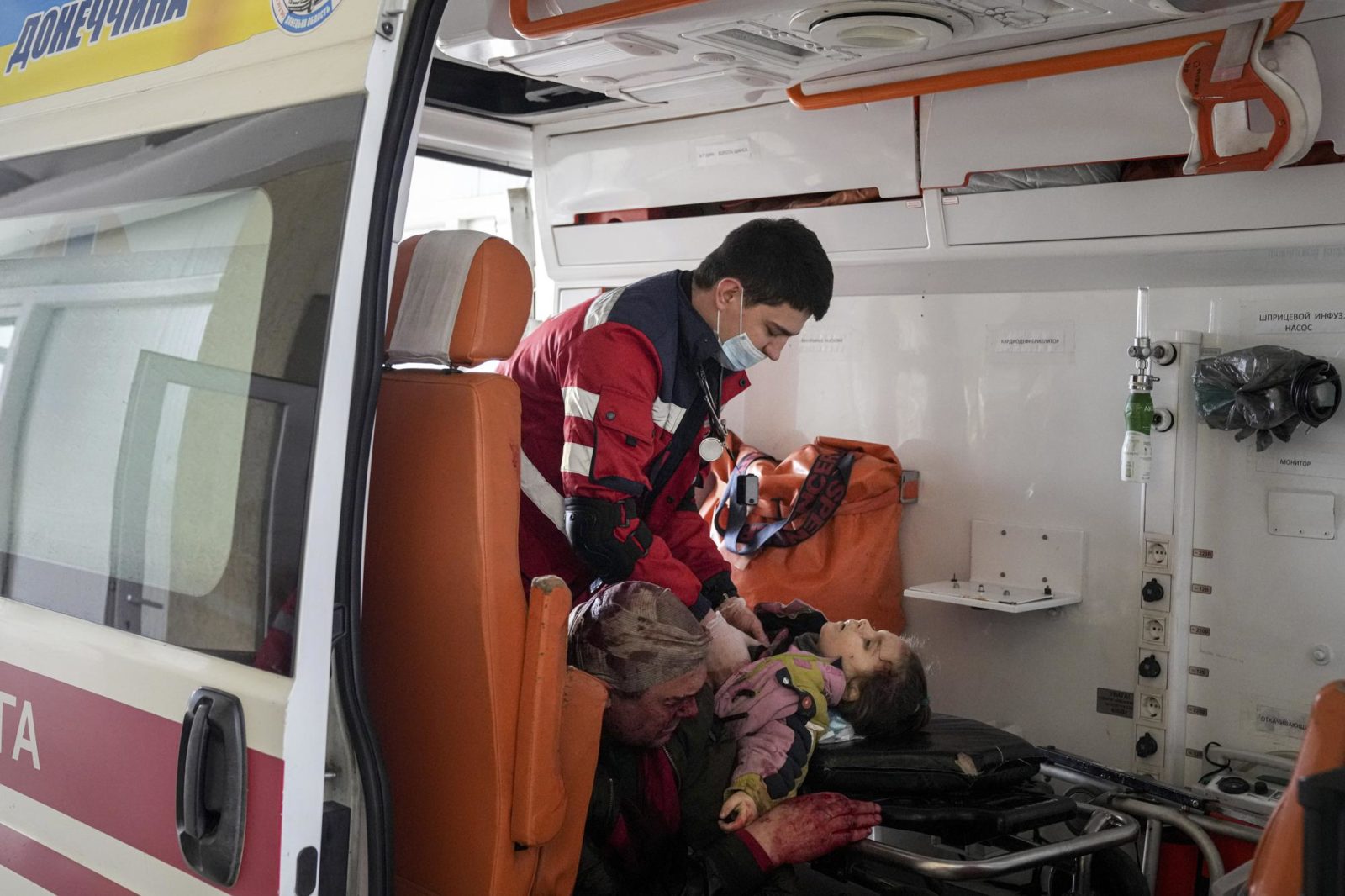
Oleksandr Konovalov, an ambulance paramedic, performs CPR on a girl injured by shelling in a residential area as her dad sits, left, after arriving at the city hospital of Mariupol, eastern Ukraine, Sunday, Feb. 27, 2022. The girl did not survive. (AP Photo/Evgeniy Maloletka)
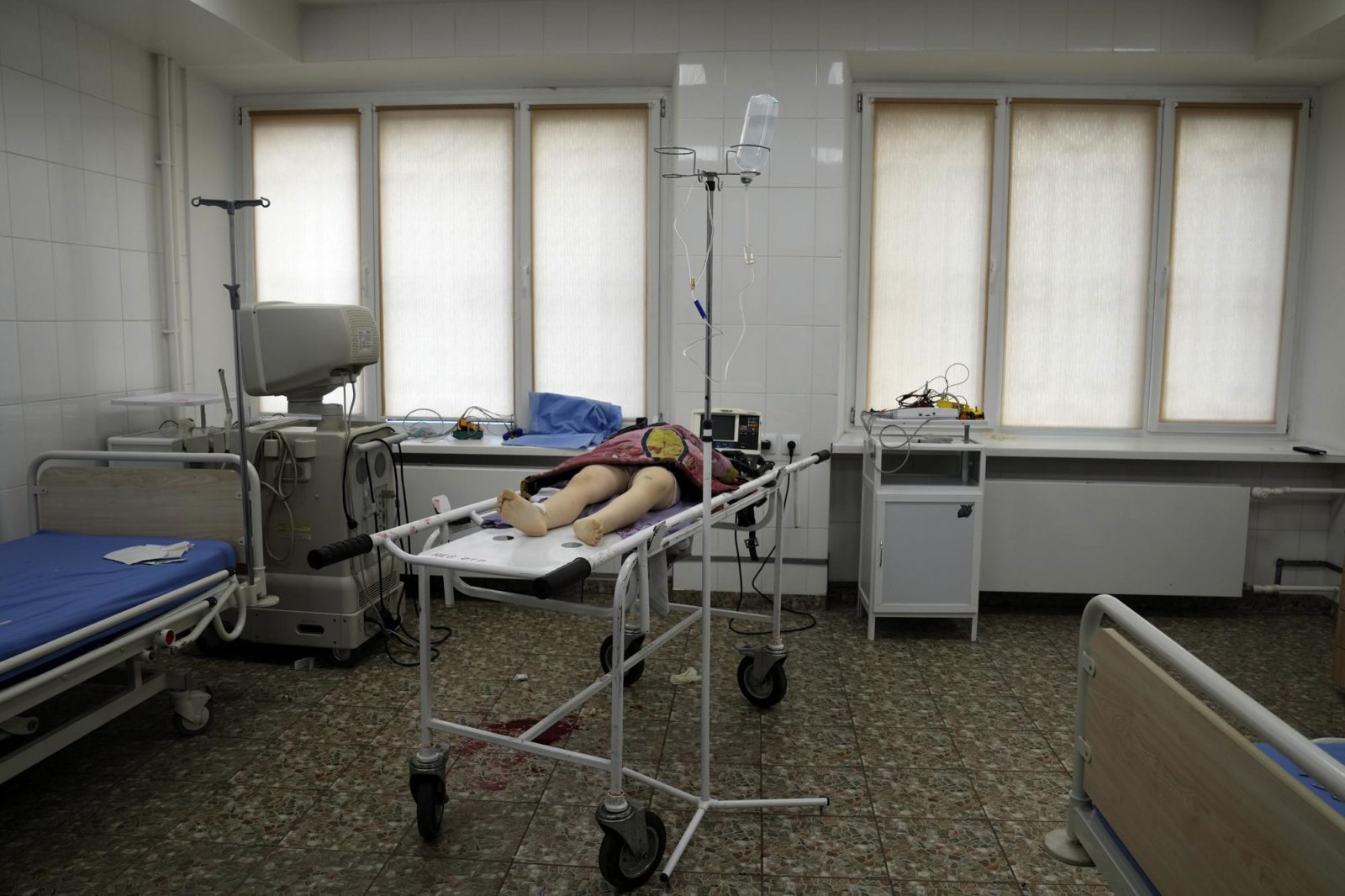
The lifeless body of a girl killed during shelling at a residential area lies on a medical cart at the city hospital of Mariupol, eastern Ukraine, Sunday, Feb. 27, 2022. (AP Photo/Evgeniy Maloletka)
The same geography that for so long worked in Mariupol’s favor had turned against it. The city stands squarely between regions controlled by the Russia-backed separatists — about 10 kilometers (six miles) to the east at the closest point — and the Crimean Peninsula annexed by Russia in 2014. The capture of Mariupol would give the Russians a clear land corridor all the way through, controlling the Sea of Azov.
As February ended, the siege began. Ignoring the danger, or restless, or perhaps just feeling invincible as teenagers do, a group of boys met up a few days later, on March 2, to play soccer on a pitch outside a school.
A bomb exploded. The blast tore through Iliya’s legs.
The odds were against him, and increasingly against the city. The electricity went out yet again, as did most mobile networks. Without communications, medics had to guess which hospitals could still handle the wounded and which roads could still be navigated to reach them.
Iliya couldn’t be saved. His father, Serhii, dropped down, hugged his dead boy’s head and wailed out his grief.
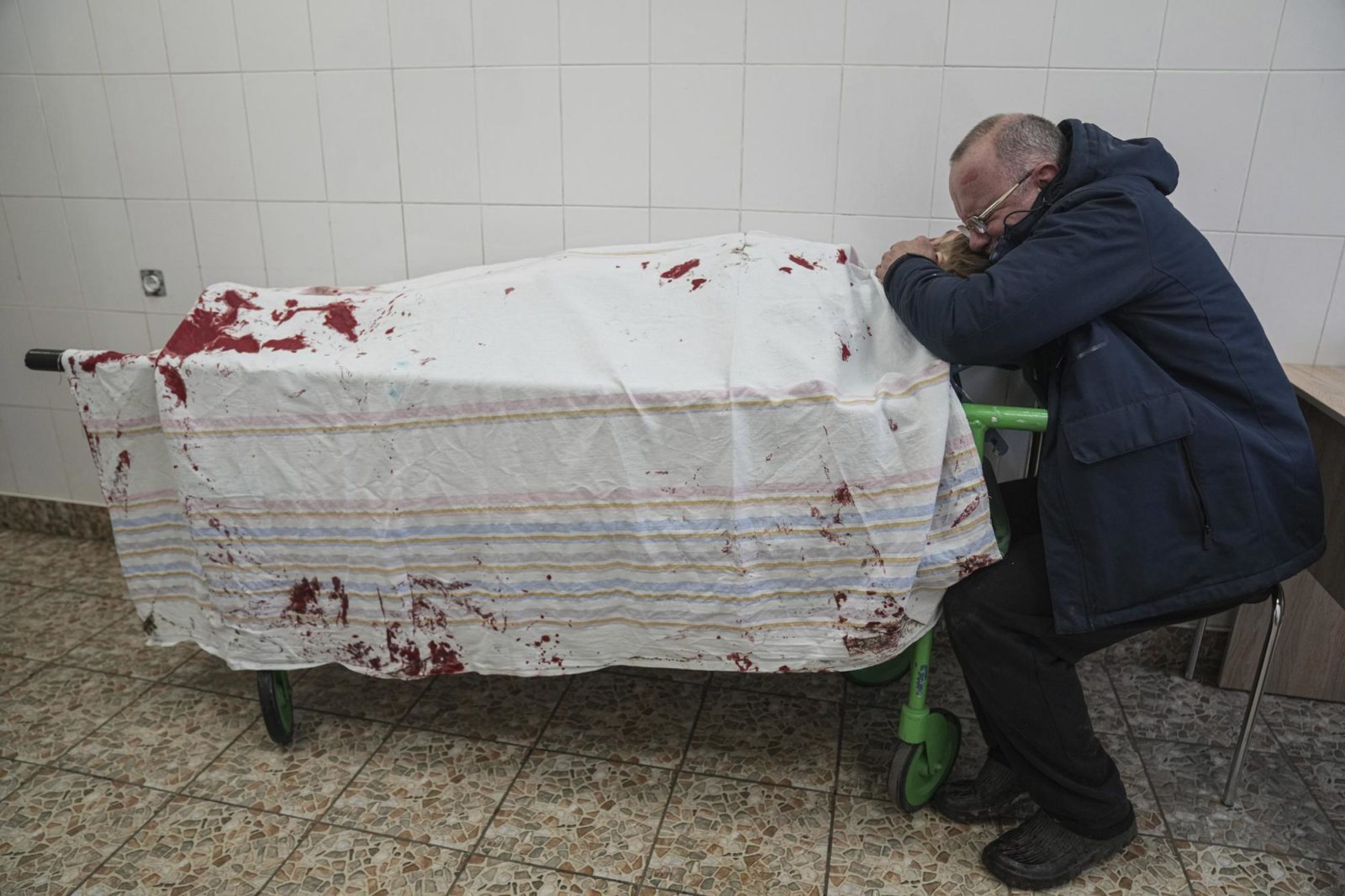
Serhii, father of teenager Iliya, cries on his son’s lifeless body lying on a stretcher at a maternity hospital converted into a medical ward in Mariupol, Ukraine, March 2, 2022. (AP Photo/Evgeniy Maloletka)
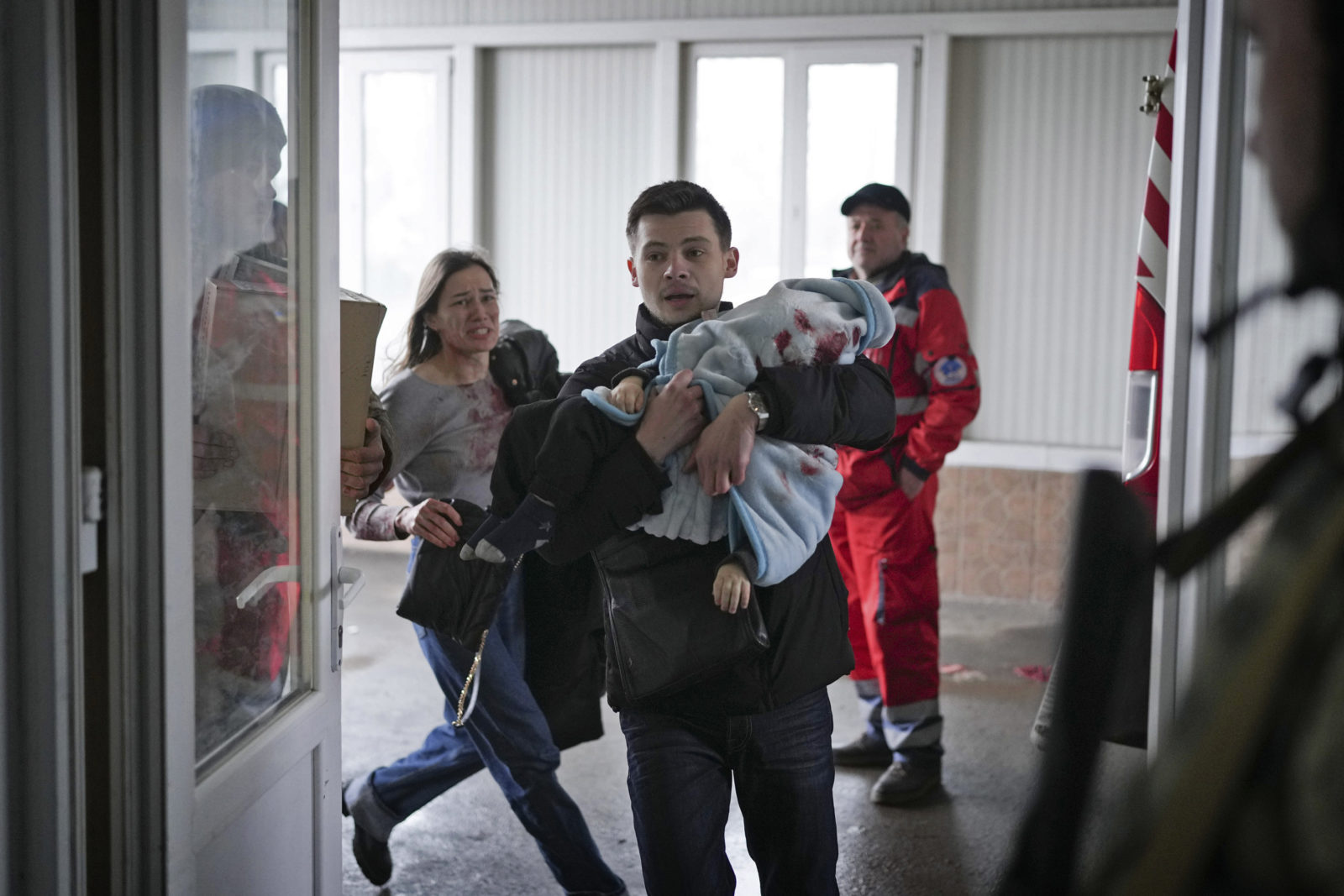
Marina Yatsko, left, runs behind her boyfriend Fedor carrying her 18 month-old son Kirill who was fatally wounded in shelling, as they arrive at a hospital in Mariupol, Ukraine, Friday, March 4, 2022. (AP Photo/Evgeniy Maloletka)
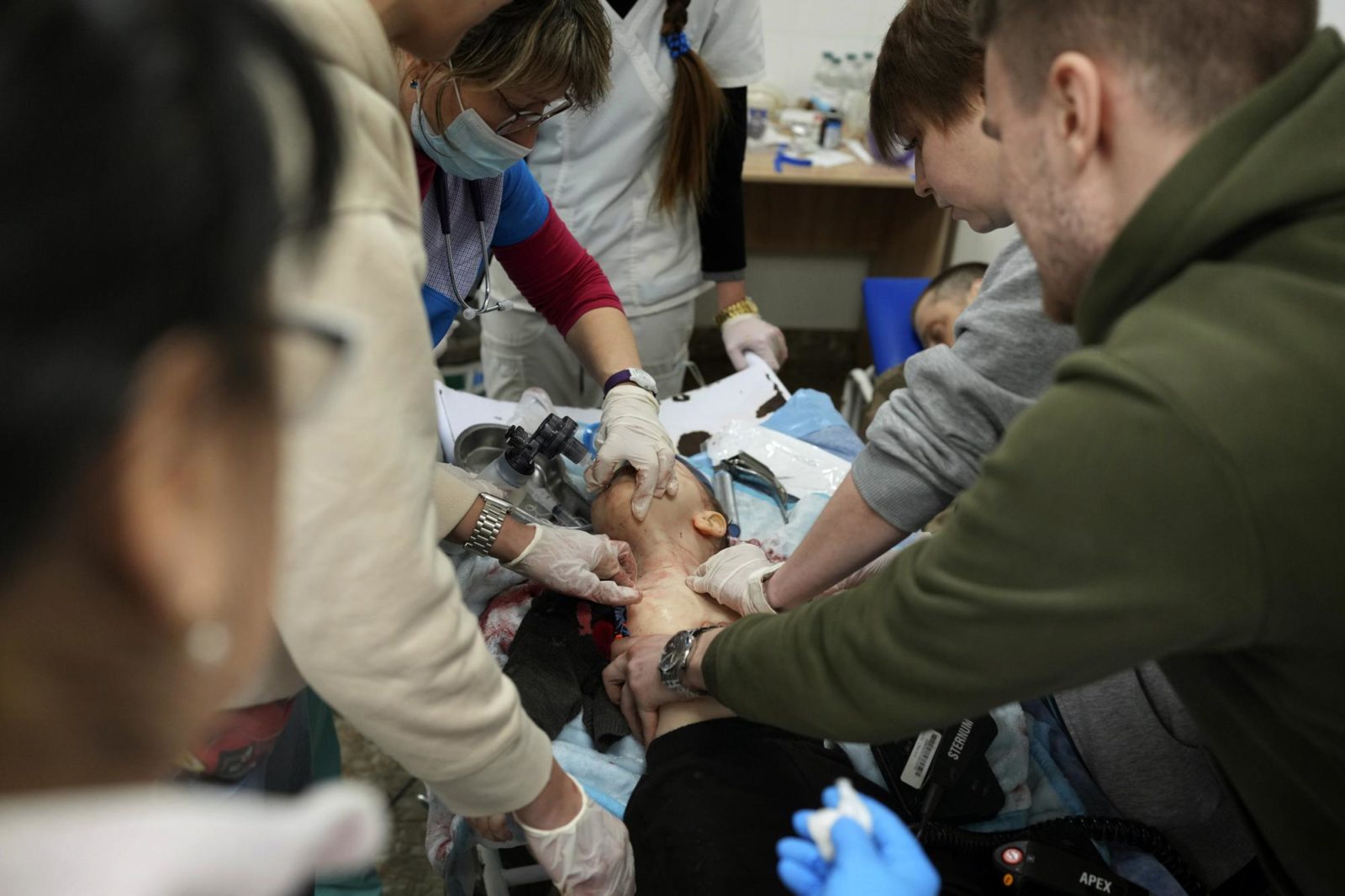
Medical workers unsuccessfully try to save the life of Marina Yatsko’s 18 month-old son Kirill, who was fatally wounded by shelling, at a hospital in Mariupol, Ukraine, March 4, 2022. (AP Photo/Evgeniy Maloletka)
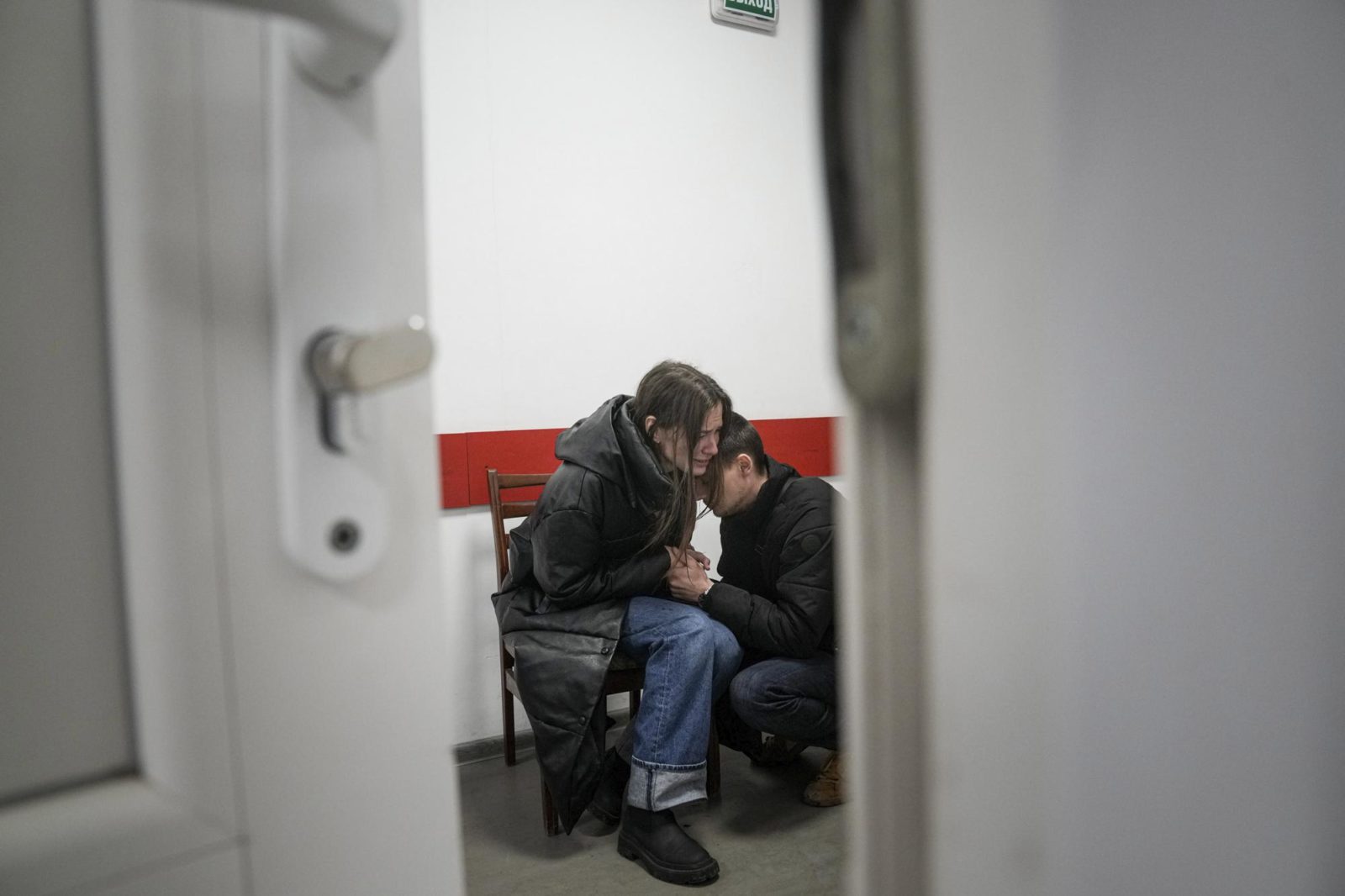
Marina Yatsko and her boyfriend Fedor comfort each other after her 18-month-old son Kirill was killed in shelling in a hospital in Mariupol, Ukraine, March 4, 2022. (AP Photo/Evgeniy Maloletka)
On March 4, it was yet another child in the emergency room — Kirill, the toddler struck in the head by shrapnel. His mother and stepfather bundled him in a blanket. They hoped for the best, and then endured the worst.
“Why? Why? Why?” his sobbing mother, Marina Yatsko, asked in the hospital hallway, as medical workers looked on helplessly. She tenderly unwrapped the blanket around her lifeless child to kiss him and inhale his scent one last time, her dark hair falling over him.
That was the day the darkness settled in for good — a blackout in both power and knowledge. Ukrainian television and radio were cut, and car stereos became the only link to the outside world. They played Russian news, describing a world that couldn’t be further from the reality in Mariupol.
As it sunk in that there was truly no escape, the mood of the city changed. It didn’t take long for grocery store shelves to empty. Mariupol’s residents cowered by night in underground shelters and emerged by day to grab what they could before scurrying underground again.
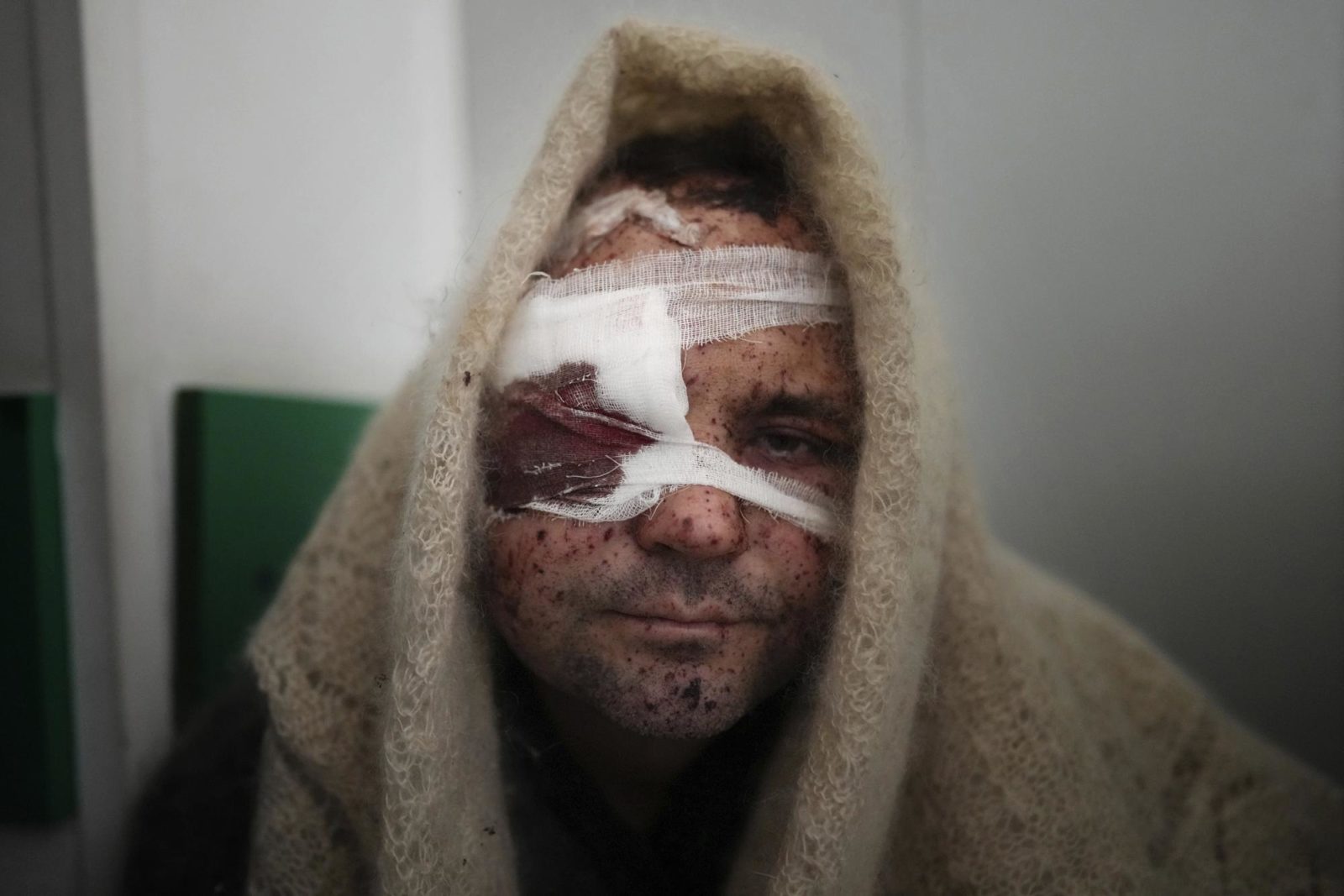
Serhiy Kralya, 41, looks at the camera after surgery at a hospital in Mariupol, eastern Ukraine on March 11, 2022. Kralya was injured during shelling by Russian forces. (AP Photo/Evgeniy Maloletka)
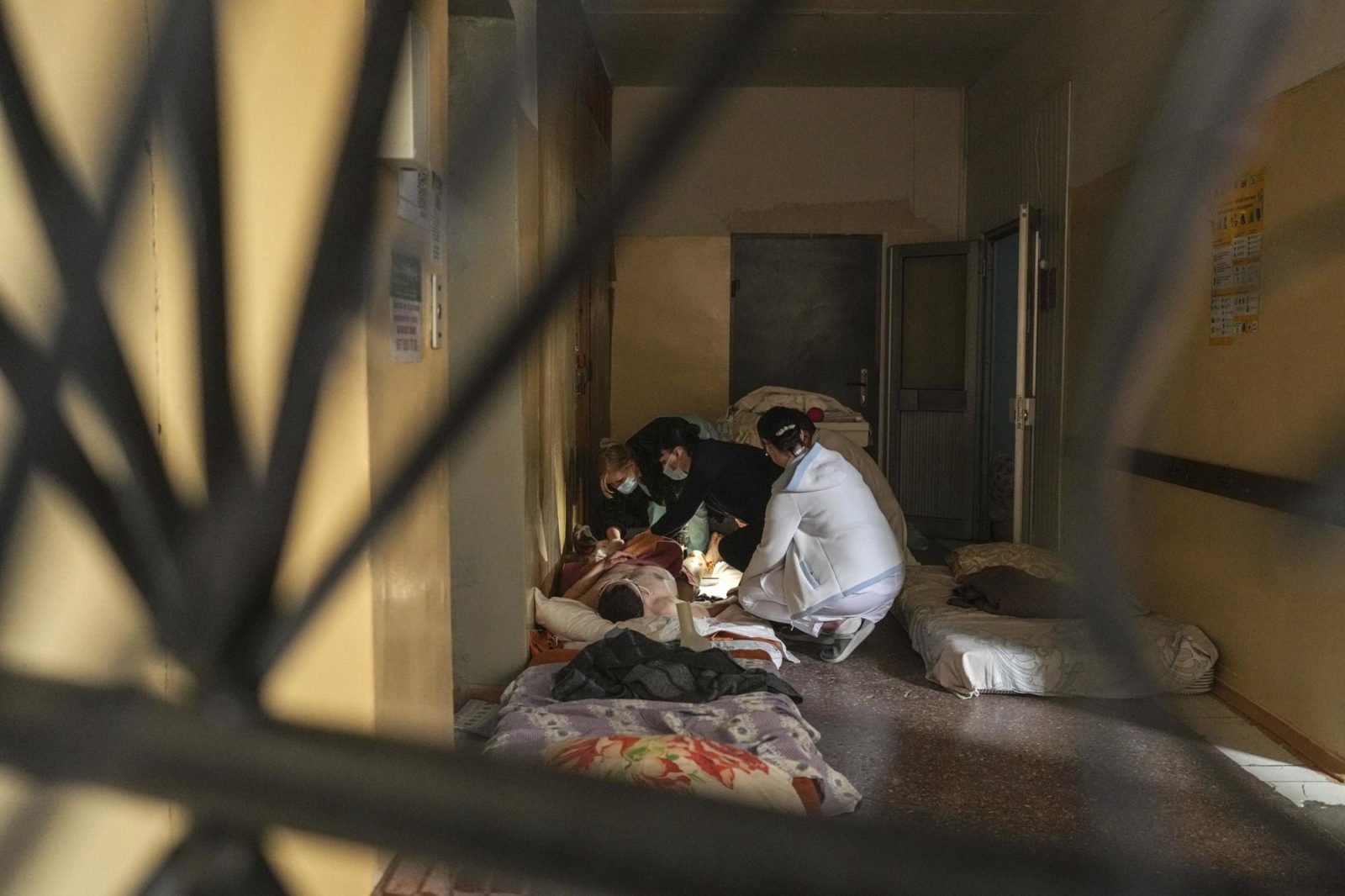
Medical workers treat a man wounded by shelling in a hospital in Mariupol, Ukraine, March 4, 2022. (AP Photo/Evgeniy Maloletka)
On March 6, in the way of desperate people everywhere, they turned on each other. On one street lined with darkened stores, people smashed windows, pried open metal shutters, grabbed what they could.
A man who had broken into a store found himself face to face with the furious shopkeeper, caught red-handed with a child’s rubber ball.
“You bastard, you stole that ball now. Put the ball back. Why did you even come here?” she demanded. Shame written on his face, he tossed the ball into a corner and fled.
Nearby, a soldier emerged from another looted store, on the verge of tears.
“People, please be united. … This is your home. Why are you smashing windows, why are you stealing from your shops?” he pleaded, his voice breaking.
Yet another attempt to negotiate an evacuation failed. A crowd formed at one of the roads leading away from the city, but a police officer blocked their path.
“Everything is mined, the ways out of town are being shelled,” he told them. “Trust me, I have family at home, and I am also worried about them. Unfortunately, the maximum security for all of us is to be inside the city, underground and in the shelters.”
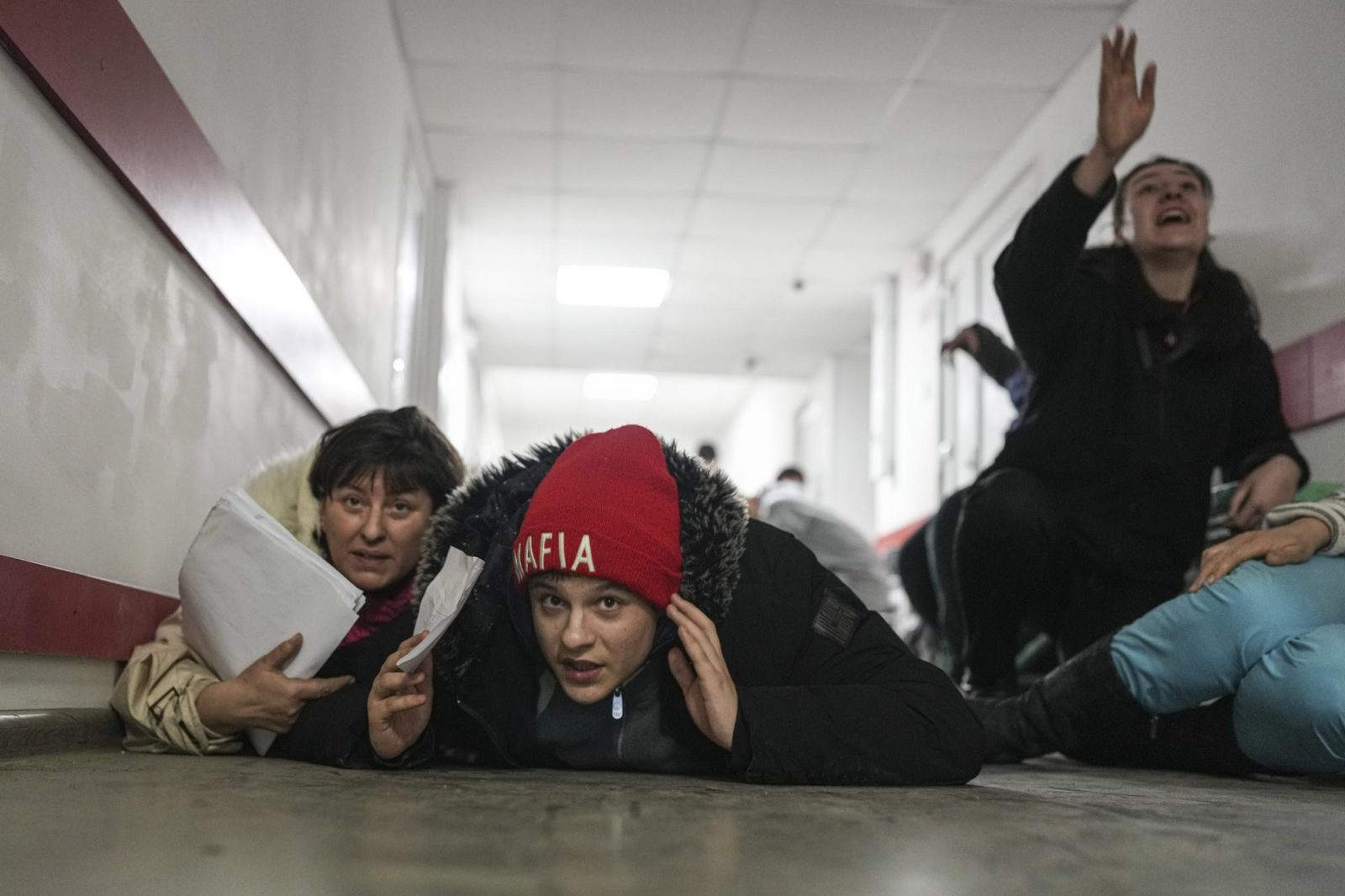
People lie on the floor of a hospital during shelling by Russian forces in Mariupol, Ukraine, March 4, 2022. (AP Photo/Evgeniy Maloletka)
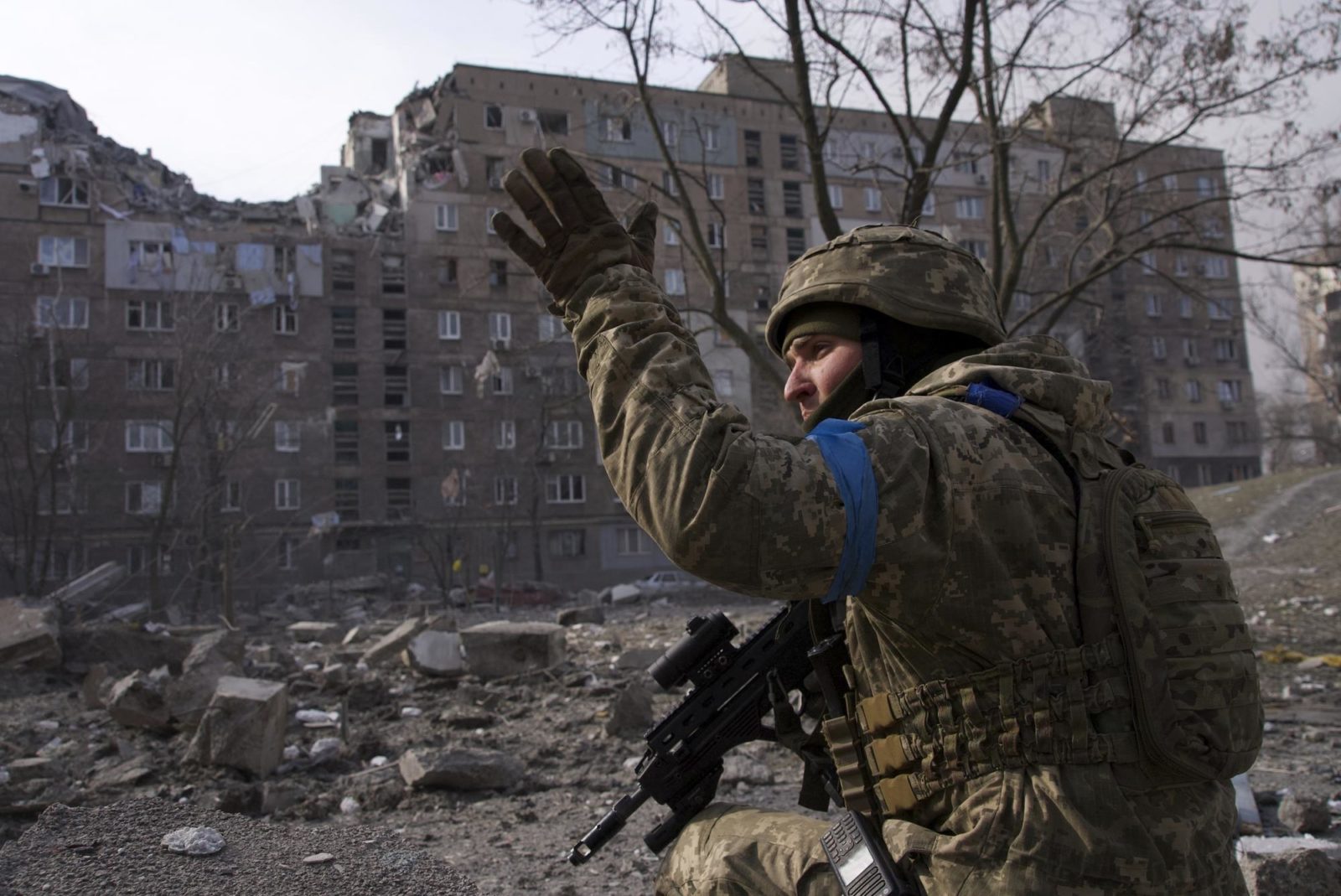
A Ukrainian serviceman guards his position in Mariupol, Ukraine, March 12, 2022.(AP Photo/Mstyslav Chernov)
And that’s where Goma Janna could be found that night, weeping beside an oil lamp that threw light but not enough heat to take the chill off the basement room. She wore a scarf and a cheery turquoise snowflake sweater as she roughly rubbed the tears from her face, one side at a time. Behind her, beyond the small halo of light, a small group of women and children crouched in the darkness, trembling at the explosions above.
“I want my home, I want my job. I’m so sad about people and about the city, the children,” she sobbed.
This agony fits in with Putin’s goals. The siege is a military tactic popularized in medieval times and designed to crush a population through starvation and violence, allowing an attacking force to spare its own soldiers the cost of entering a hostile city. Instead, civilians are the ones left to die, slowly and painfully.
Putin has refined the tactic during his years in power, first in the Chechen city of Grozny in 2000 and then in the Syrian city of Aleppo in 2016. He reduced both to ruins.
“It epitomizes Russian warfare, what we see now in terms of the siege,” said Mathieu Boulegue, a researcher for Chatham House’s Russia program.
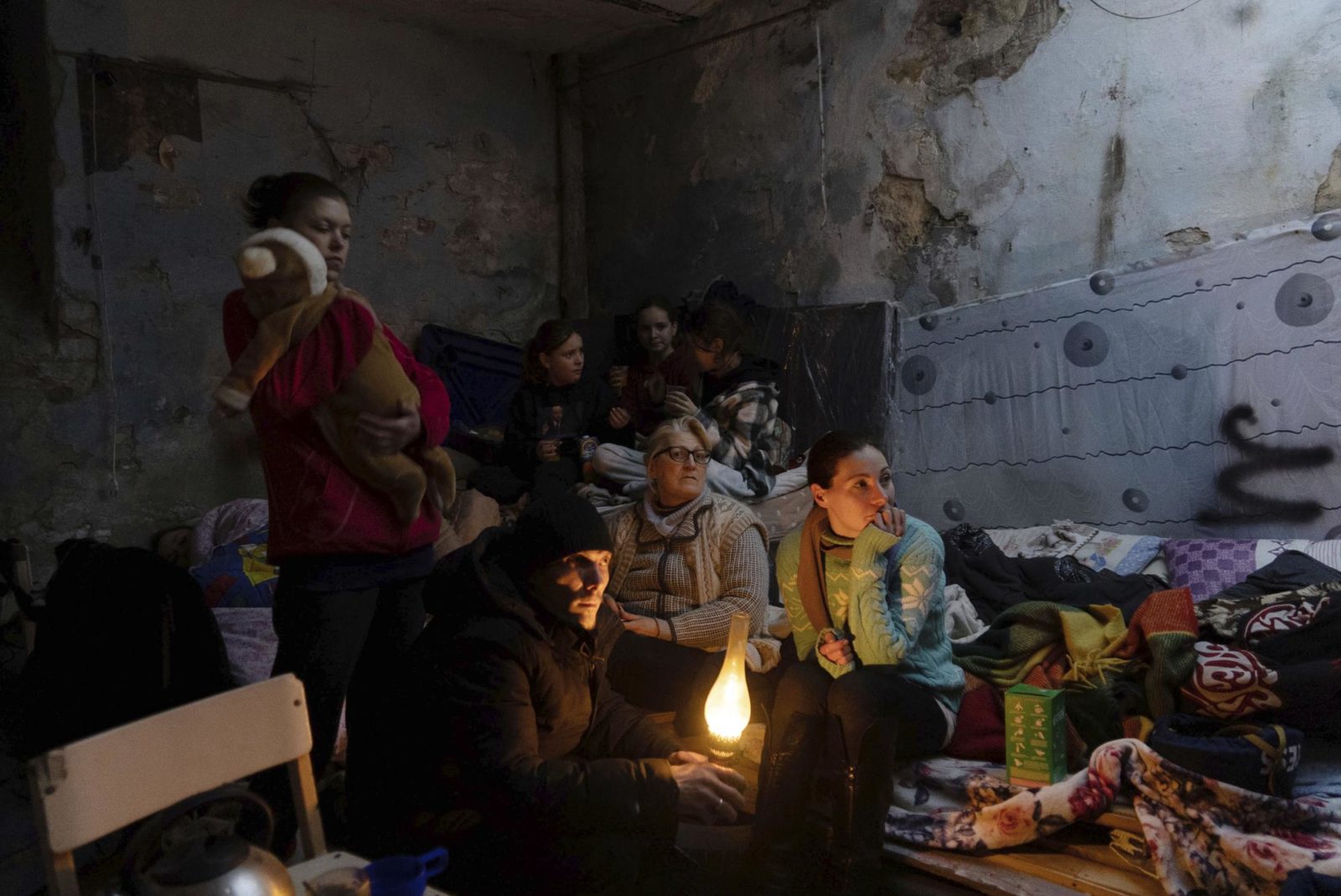
People settle in a bomb shelter in Mariupol, Ukraine, March 6, 2022. (AP Photo/Evgeniy Maloletka)
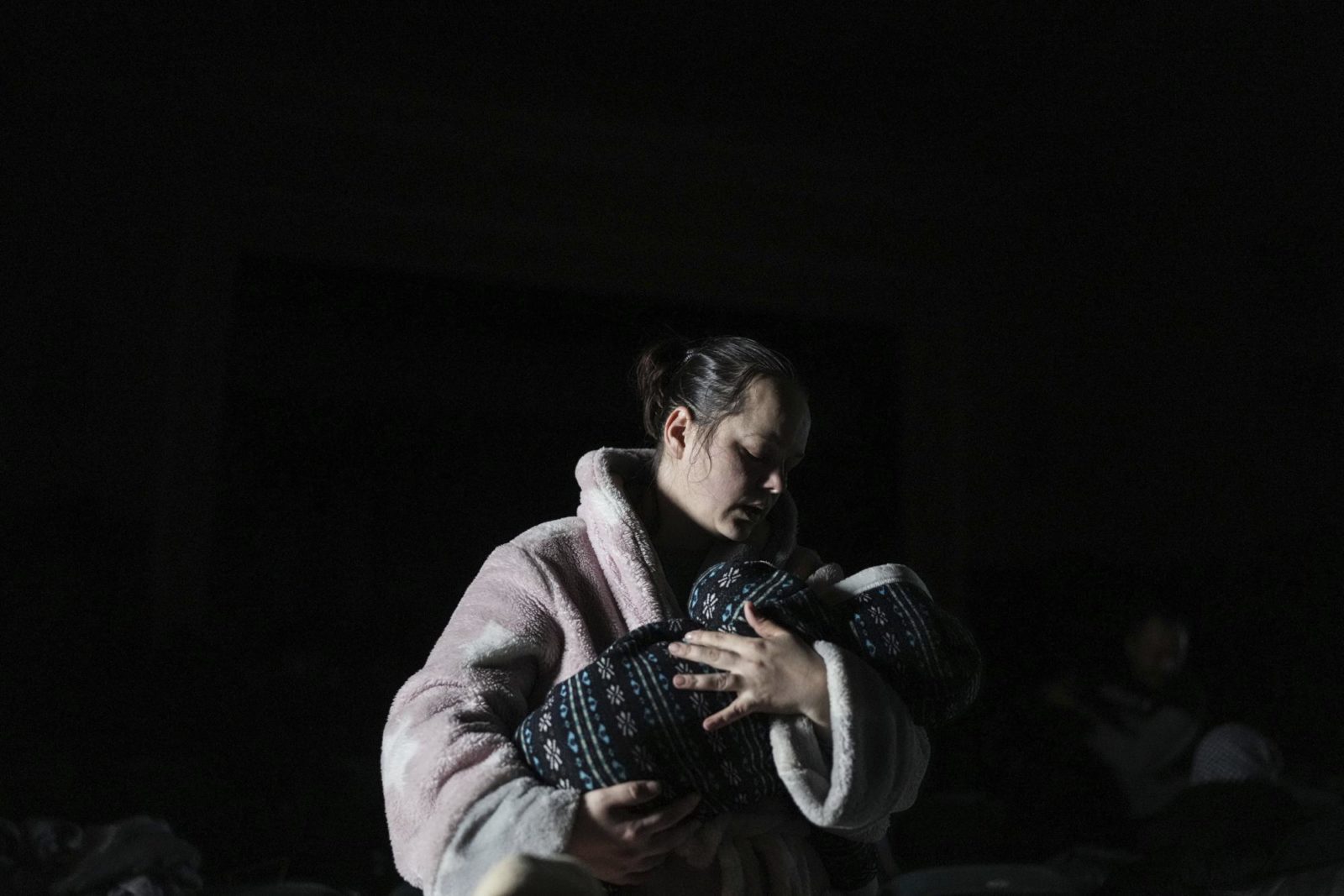
A woman holds a baby in a bomb shelter in Mariupol, Ukraine, March 8, 2022. (AP Photo/Evgeniy Maloletka
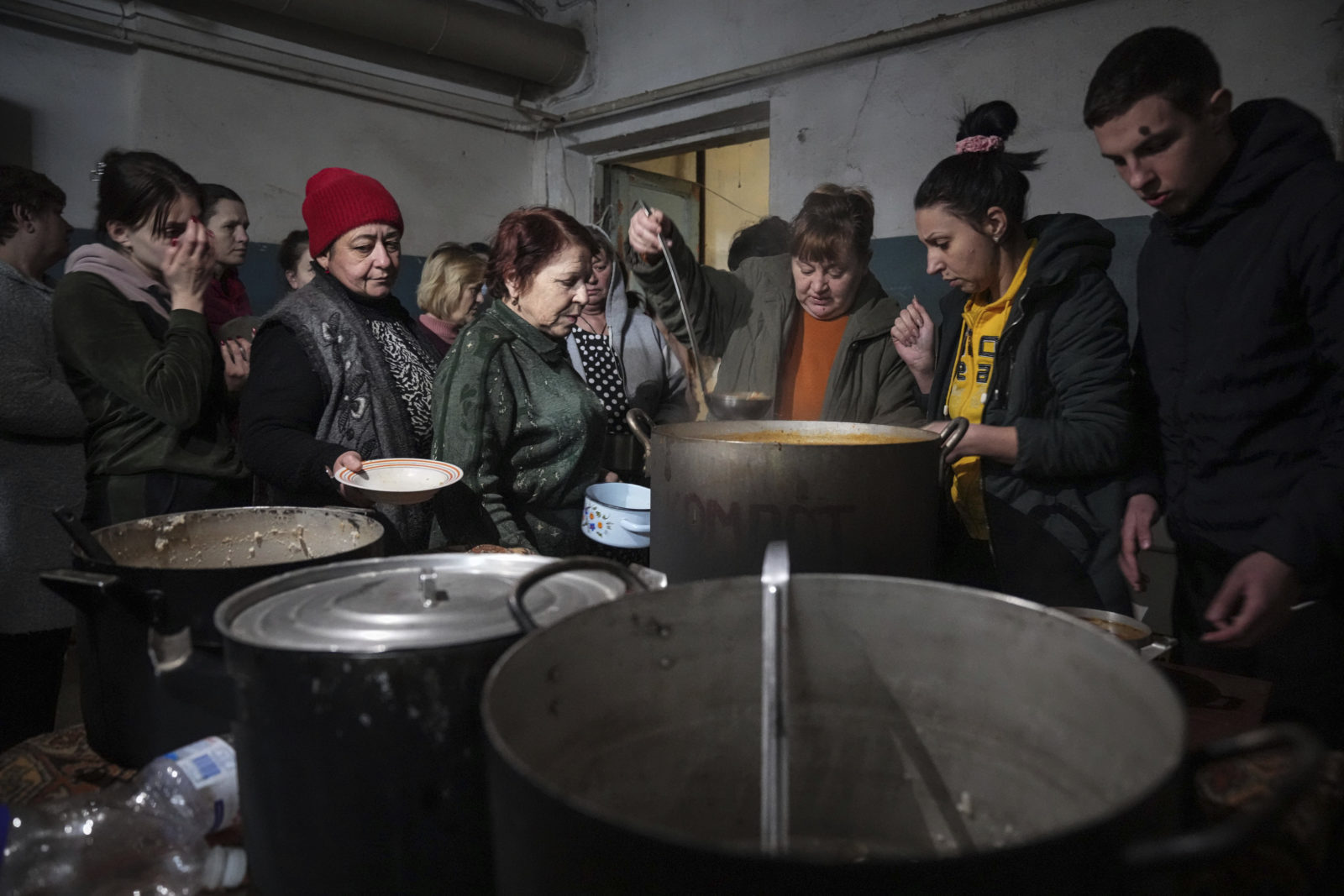
People queue to receive hot food in a improvised bomb shelter in Mariupol, Ukraine, Monday, March 7, 2022. (AP Photo/Evgeniy Maloletka)
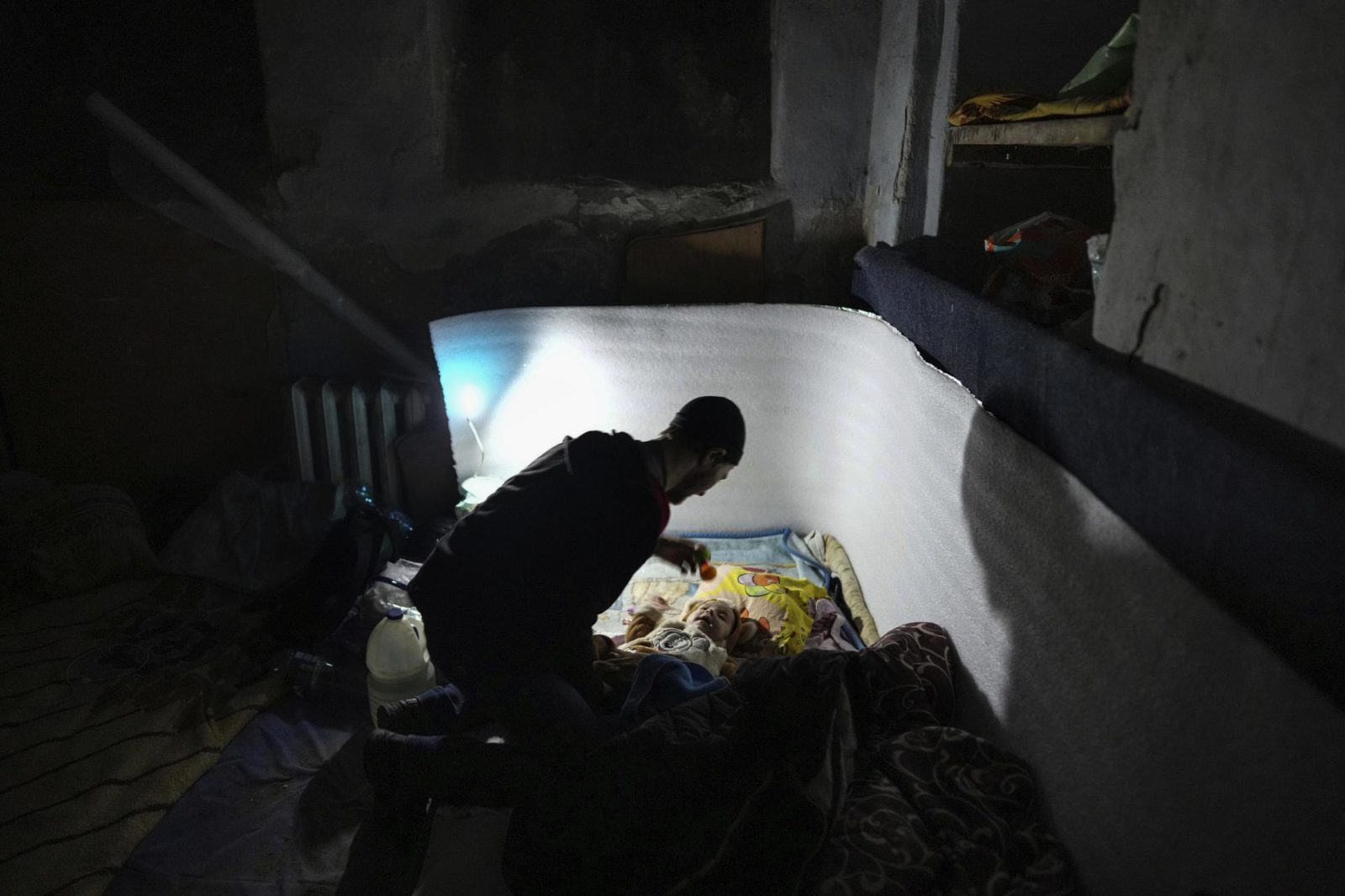
A man plays with a baby in a bomb shelter in Mariupol, Ukraine, March 6, 2022. (AP Photo/Evgeniy Maloletka
By March 9, the sound of Russian fighter jets in Mariupol was enough to send people screaming for cover — anything to avoid the airstrikes they knew would follow, even if they didn’t know where.
The jets rumbled across the sky, this time decimating the maternity hospital. They left a crater two stories deep in the courtyard.
Rescuers rushed a pregnant woman through the rubble and light snow as she stroked her bloodied belly, face blanched and head lolling listlessly to the side. Her baby was dying inside her, and she knew it, medics said.
“Kill me now!” she screamed, as they struggled to save her life at another hospital even closer to the front line.
The baby was born dead. A half-hour later, the mother died too. The doctors had no time to learn either of their names.
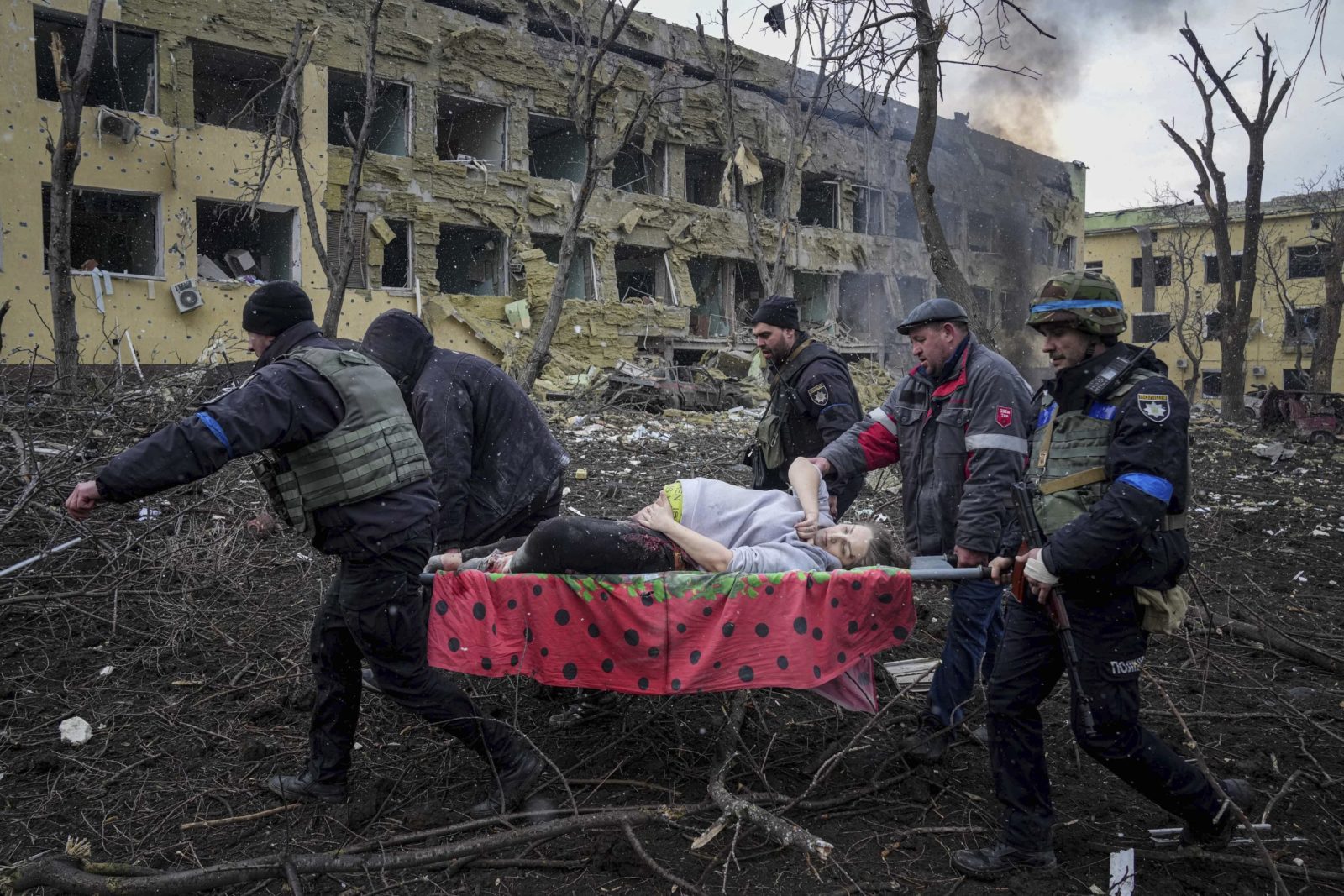
Ukrainian emergency employees and volunteers carry an injured pregnant woman from a maternity hospital damaged by shelling in Mariupol, Ukraine, Wednesday, March 9, 2022. The baby was born dead. Half an hour later, the mother died too. (AP Photo/Evgeniy Maloletka)
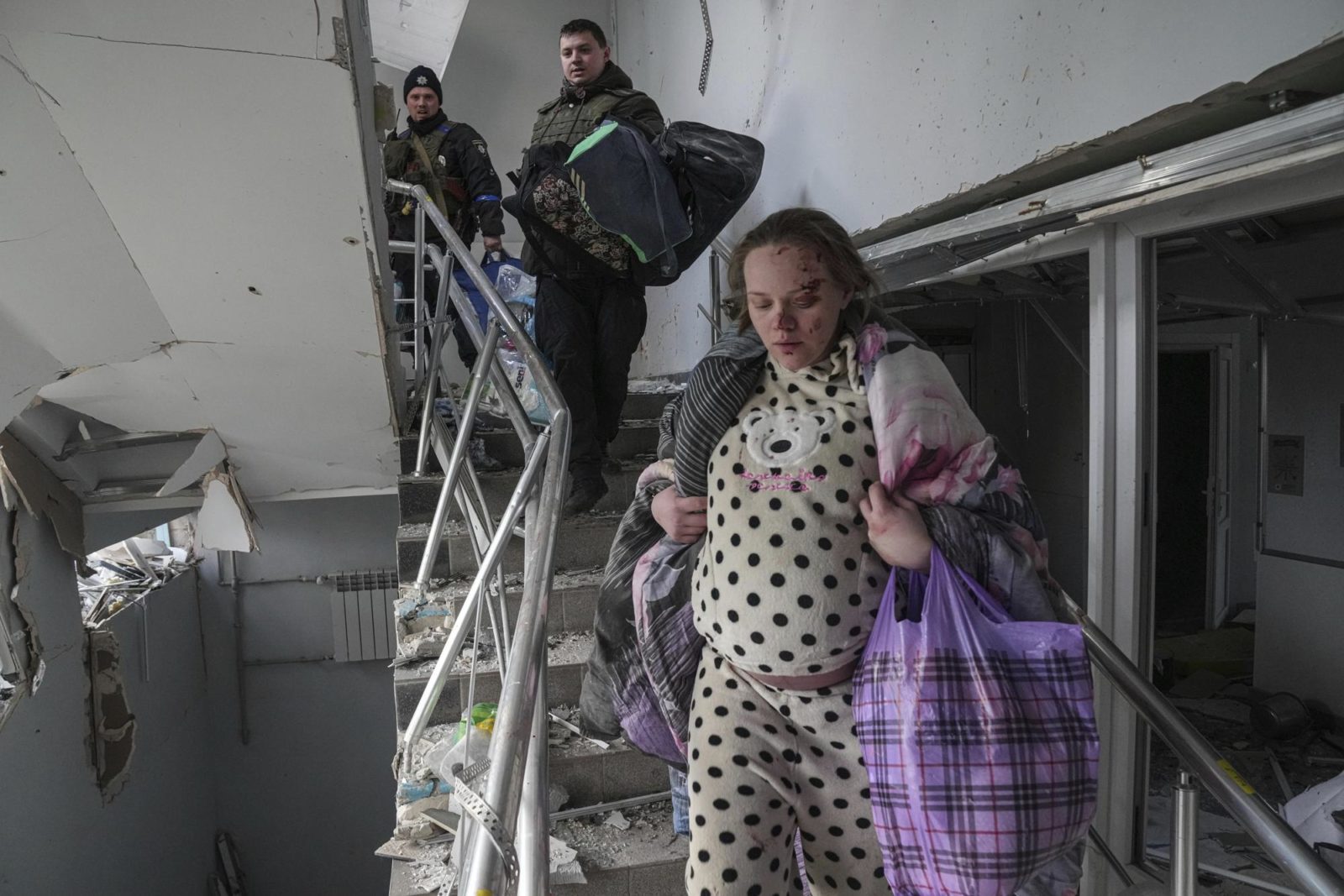
Mariana Vishegirskaya walks down stairs in a maternity hospital damaged by shelling in Mariupol, Ukraine, March 9, 2022. (AP Photo/Evgeniy Maloletka
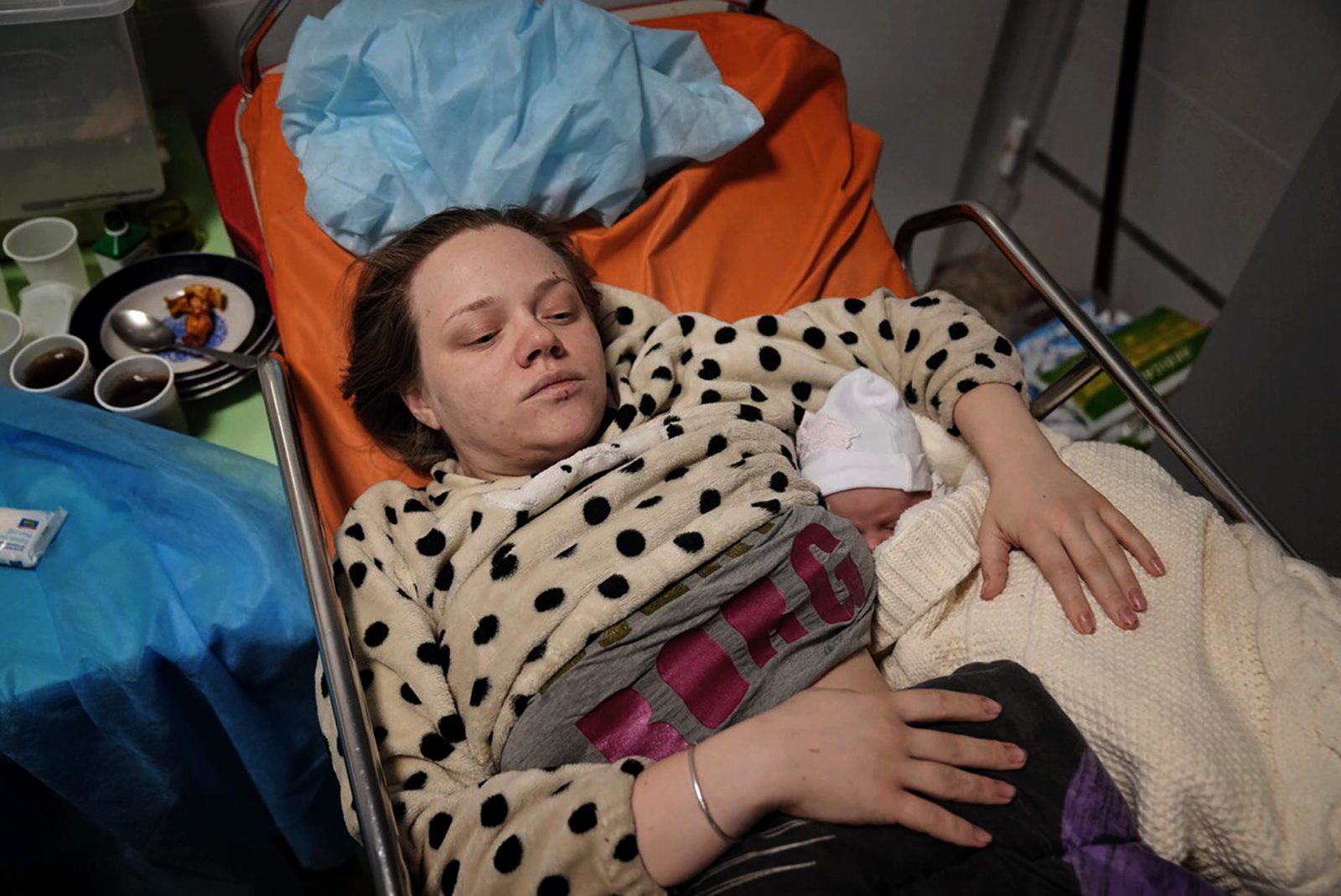
Mariana Vishegirskaya lies in a hospital bed after giving birth to her daughter Veronika, in Mariupol, Ukraine, March 11, 2022. (AP Photo/Evgeniy Maloletka)
Another pregnant woman, Mariana Vishegirskaya, was waiting to give birth at the maternity hospital when the strike hit. Her brow and cheek bloodied, she clutched her belongings in a plastic bag and navigated the debris-strewn stairs in polka-dot pajamas. Outside the ruined hospital, she stared motionless with wide blue eyes at the crackling flames.
Vishegirskaya delivered her child the next day to the sound of shellfire. Baby Veronika drew her first breath on March 10.
The two women — one dead and one a mother — have since become the symbol of their blackened, burning hometown. Facing worldwide condemnation, Russian officials claimed that the maternity hospital had been taken over by far-right Ukrainian forces to use as a base and emptied of patients and nurses.
In two tweets, the Russian Embassy in London posted side-by-side images of AP photos with the word “FAKE” over them in red text. They claimed that the maternity hospital had long been out of operation, and that Vishegirskaya was an actress playing a role. Twitter has since removed the tweets, saying they violated its rules.
The AP reporters in Mariupol who documented the attack in video and photos saw nothing to indicate the hospital was used as anything other than a hospital. There is also nothing to suggest Vishegirskaya, a Ukrainian beauty blogger from Mariupol, was anything but a patient. Veronika’s birth attests to the pregnancy that her mother carefully documented on Instagram, including one post in which she is wearing the polka-dot pajamas.
Two days after Veronika was born, four Russian tanks emblazoned with the letter Z took up position near the hospital where she and her mother were recovering. An AP journalist was among a group of medical workers who came under sniper fire, with one hit in the hip.
The windows rattled, and the hallways were lined with people with nowhere else to go. Anastasia Erashova wept and trembled as she held a sleeping child. Shelling had just killed her other child as well as her brother’s child, and Erashova’s scalp was encrusted with blood.
“I don’t know where to run to,” she cried out, her anguish growing with every sob. “Who will bring back our children? Who?”
By early this week, Russian forces had seized control of the building entirely, trapping medics and patients inside and using it as a base, according to a doctor there and local officials.
Orlov, the deputy mayor, predicted worse is soon to come. Most of the city remains trapped.
“Our defenders will defend to the last bullet,” he said. “But people are dying without water and food, and I think in the next several days we will count hundreds and thousands of deaths.”
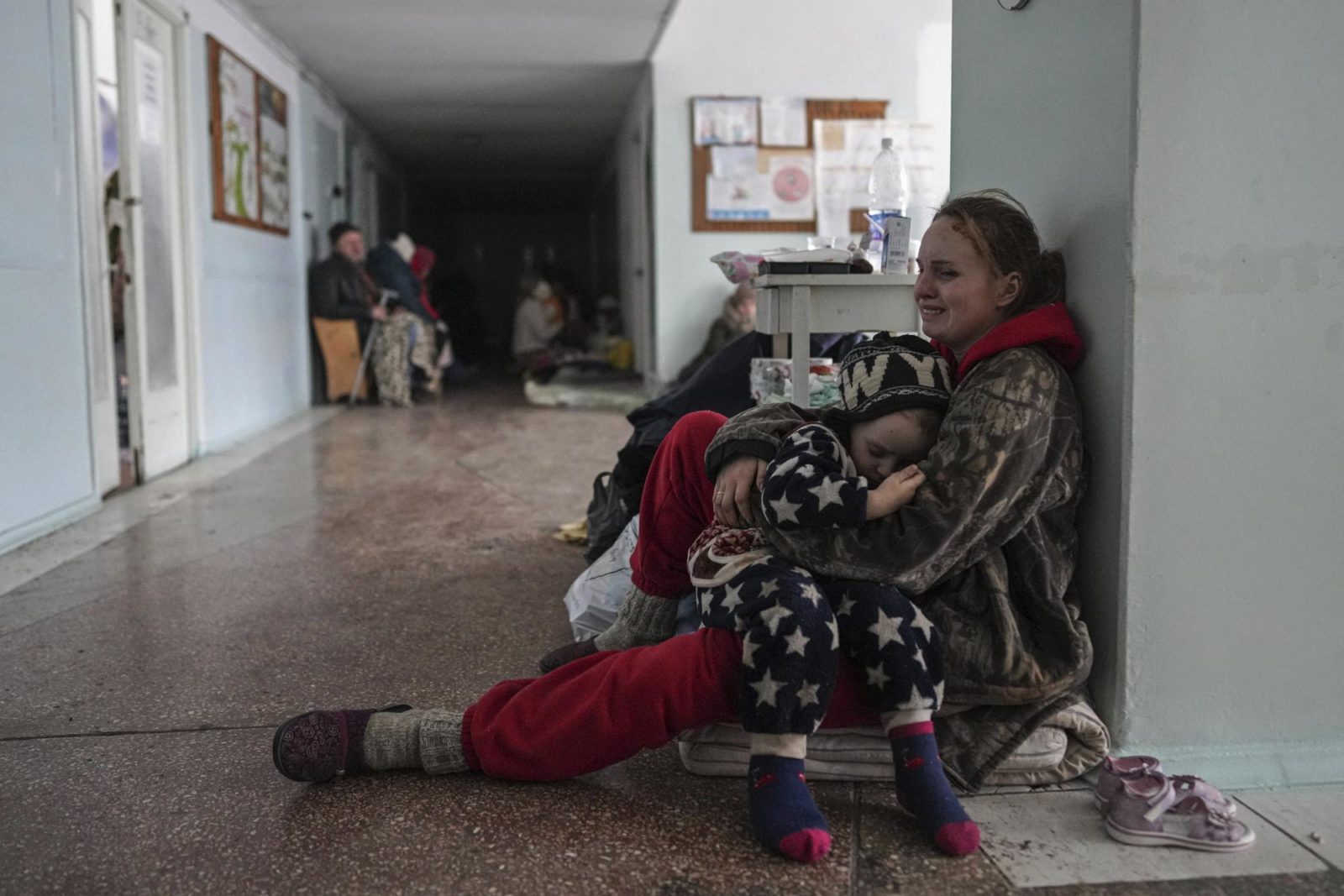
Anastasia Erashova cries as she hugs her child in a corridor of a hospital in Mariupol, Ukraine, March 11, 2022. (AP Photo/Evgeniy Maloletka)
Suicide missions, abuse, physical threats: International Legion fighters speak out against leadership’s misconduct
Added on Dec. 1, 2022: In November, the Kyiv Independent ran a follow-up to this investigation. This second story looks into other alleged misconduct of the leadership of the International Legion, including light weapons misappropriation and physical threats toward soldiers. Read it here.
Disclaimer: The Kyiv Independent is publishing this investigation to shed light on the alleged abuse of power in the leadership of one wing of the International Legion – a legion created for foreign fighters dedicated to defending Ukraine. The members of the Legion’s unit say that they reported their commanders’ misconduct to Ukrainian law enforcement, the parliament, and President Volodymyr Zelensky’s Office, but saw no proper reaction and thus turned to journalists as a last resort. Soldiers who pointed at the problems within this unit of the Legion claim they received threats for speaking up. For their safety, we do not disclose their identities.
Top findings:
- The leadership of the intelligence-run wing of the International Legion is allegedly implicated in various violations, including abuse, theft, and sending soldiers unprepared on reckless missions.
- One of the unit’s commanders and a frequent subject of the soldiers’ complaints is an alleged former member of a criminal organization from Poland, wanted at home for fraud. In the Legion’s unit, he is involved in coordinating military operations and logistics.
- The legion’s fighters accuse him of abusing power by ordering soldiers to loot shops, threatening soldiers with a gun, and sexually harassing the legion’s female medics.
In early May, a fighter from Brazil arrived in Ukraine to join the International Legion following President Volodymyr Zelensky’s call to “citizens of the world” to come and help defend Ukraine.
He thought his vast experience in the Brazilian army had prepared him for pretty much any task.
Yet he was neither ready to carry out suicide missions by order of his command, nor to tolerate orders to loot and steal.
As a platoon commander of the International Legion, he was ordered to do just that.
The Brazilian officer recalls his subordinates saying, before resigning from the legion: “We came here to help these people to fight for this country, against this invasion. We didn’t come here to do exactly what f*cking Russian people do when they’re on Ukrainian soil.”
The Kyiv Independent’s investigation reveals endemic problems in one of the International Legion’s wings that is overseen by Ukraine’s intelligence.
Some of the unit’s commanders are implicated in arms and goods theft, sexual harassment, assault, and sending unprepared soldiers on reckless missions, according to multiple sources.
The allegations in this story are based on interviews with legionnaires, written testimonies of over a dozen former and current members of the legion, and a 78-page report they’ve put together about problems within this particular unit of the International Legion.
For about four months, foreign fighters have been knocking on the doors of high offices asking for help. The report was filed to the parliament, and written testimonies were sent to Zelensky’s office. Alyona Verbytska, the president’s commissioner for soldiers’ rights, confirmed she had received legionnaires’ complaints and passed them on to law enforcement.
But authorities, soldiers say, are reluctant to solve the issue.
Failed leadership?
The International Legion, soldiers say, consists of two wings. Ukraine’s Ground Forces oversee one. The Defense Ministry’s Directorate for Intelligence, known under its Ukrainian acronym GUR, coordinates the other.
The allegations in this report concern the GUR-run wing of the Legion. At its strongest, this unit had up to 500 people, and comprised about one-third of the International Legion, according to the Kyiv Independent’s sources among the soldiers.
GUR did not respond to the Kyiv Independent’s request for comment by publication time.
According to members of the intelligence-run wing of the Legion, their commanders report directly to the head of GUR, Kyrylo Budanov, who Zelensky also appointed to head the intelligence committee in the president’s office in late July.
Officially, the GUR wing of the Legion is run by major Vadym Popyk. However, he is not running the unit on his own.
The power is in the hands of a few people: Popyk’s right hand, major Taras Vashuk (referred to by soldiers as “young Taras”), an intelligence officer in his late 20s or early 30s, according to the foreign fighters; Vashuk’s uncle, also Taras (referred to as “old” Taras) and also an intelligence officer; and 60-year old Sasha Kuchynsky.
“They are like best buds,” an American legionnaire told the Kyiv Independent of the three men.
Young Taras, old Taras, and Sasha run the operations of the unit. They send soldiers on missions and coordinate the intelligence wing of the Legion’s work. Sasha is also in charge of logistics and supplies.
The legionnaires accuse the trio of various wrongdoings. For the two Tarases, the major complaints concern them sending soldiers on suicide missions.
An American soldier interviewed by the Kyiv Independent described a couple of missions that took place near the southern city of Mykolaiv, one of the war’s hot spots.
Russian troops discovered their squad’s position and started to shell it heavily. The rest of the troops retreated from the secondary position behind them, leaving the squad to hold the front line alone, with no backup.
“We were literally left (behind) and they didn’t want to evacuate us,” the soldier said. His fellow soldier, Scott Sibley, was killed, while three others were severely injured on that mission.
Shortly after the squad escaped the shelling, another group from the same unit was ordered to take the same position.
“We told the commander those positions were discovered by Russians… If we go back there, we are all dead,” the American soldier told the Kyiv Independent.
The older Taras did not listen and sent another group to the very same place, the soldier said. The story repeated itself, but this time with four killed, multiple injured, and one taken captive. The captive soldier, Andrew Hill, now faces a fake “trial” and possible execution in Russian-occupied Donetsk on accusations of being a mercenary.
Sasha Kuchynsky’s actions, however, stand out in their breadth of alleged wrongdoing.
Apart from sending fighters to die, legionnaires said, Kuchynsky forced them to help him loot stores. Fighters told the Kyiv Independent that he is also a heavy drinker who abuses his subordinates.
Another soldier, an American Jew, told the Kyiv Independent that Jewish soldiers experienced antisemitism from Kuchynsky. He emphasized that he did not encounter it from anyone else in the Ukrainian military.
The soldier also says Kuchynsky demanded to have a share of the gear and equipment that the soldier bought for his close peers from the legion. When the soldier refused to give it away, Kuchynsky pointed a gun at him.
“And then Sasha (Kuchynsky) just started yelling, screaming,” the soldier recalled. “He said, ‘I know there’s stuff here. Give me your stuff’.”
“And in front of the translator, he raises his weapon at me. And I was like: ‘You’re gonna shoot me? You’re gonna shoot me.’ And then there’s like this kind of look of, honestly, remorse, but like ‘Oh, f*ck’ and he put down his gun,” the soldier went on.
He said that he once met a legionnaire at whom Kuchynsky had also raised a gun.
According to another American legionnaire, Kuchynsky also harassed female medics in their unit, using sexually suggestive language with them. According to the American soldier, the legion’s medics complained, but nobody did anything about it. The foreign medic he knew that was harassed by Kuchynsky is no longer with the Legion and has since left Ukraine, he said.
When in trouble, legionnaires say, Kuchynsky would turn to Taras Vashuk for a cover-up.
“Sasha would call Taras and get confirmation that he can do whatever he wants to do. And Taras would constantly back him up,” a Scandinavian soldier told the Kyiv Independent.
However, to date, Kuchynsky remains in his de-facto commanding position in the Legion despite his subordinates’ complaints and despite the fact that, according to Ukrainian law, he can’t as a foreigner hold executive roles in the army.
When confronted with legionnaires’ accusations, Kuchynsky refused to address them.
“It’s up to the Military Prosecutor’s Office to address these questions,” he told the Kyiv Independent over the phone. “No comments. I’m busy.”
He then hung up.
An investigation by the Military Prosecutor’s Office wouldn’t be the first time Kuchynsky has had trouble with the law.
‘Sasha Kuchynsky’
According to the Kyiv Independent’s sources inside the legion, Sasha Kuchynsky is not the man’s real name. He is allegedly Piotr Kapuscinski, a former member of a criminal organization from Poland, who fled to Ukraine after several run-ins with the law.
Upon request from the Kyiv Independent, our colleagues from the Bellingcat investigative journalism group ran an image comparison of the photos of Sasha Kuchynsky, provided by the legionnaires, and photos of Piotr Kapuściński from Polish media. The results support the conclusion that the photos are of the same person.

An image comparison of the photos of Sasha Kuchynsky, provided by the legionnaires, and photos of Piotr Kapuściński from Polish media, support the conclusion that the photos are of the same person. (Courtesy of The Bellingcat)

An image comparison of the photos of Sasha Kuchynsky, provided by the legionnaires, and photos of Piotr Kapuściński from Polish media, support the conclusion that the photos are of the same person. (Courtesy of The Bellingcat)
In Poland, Kapuscinski is wanted for fraud and faces up to eight years in prison. According to Polish Gazeta Wyborcza, he has previously served time.
He fled Poland in 2014, and resurfaced in Ukraine two years later. He was investigated in Ukraine for aggravated robbery and sexual assault in October 2016 but was only charged with robbery. In November 2016, he was detained and spent over a year behind bars.
Warsaw asked Kyiv to extradite Kapuscinski in 2017, but Ukrainian authorities said they would first try him themselves.
He resurfaced again in May 2021, when law enforcement searched his vehicle where they found a semi-automatic pistol and bullets and proceeded to search a building that he used, finding explosives. He faced up to seven years in prison for possession of illegal weapons but was almost immediately released on bail of nearly $2,500.
After the all-out Russian war broke out in February, Kapuscinski joined the military, at which point the courts suspended his case and then paid back his bail in May 2022.
His criminal past did not prevent Kapuscinski from getting into the Legion and obtaining an executive role there. The legislation says all foreign recruits must go through background checks before joining the Ukrainian army. It’s not clear whether a criminal record counts as a deal breaker.
In Ukraine, citizens can serve in the military if they have ongoing criminal proceedings or a spent conviction. The law, however, doesn’t refer to foreigners. So when a Ukrainian court suspended Kapuscinski’s case and paid back his bail, it was applying the same norm that applies to Ukrainians.

Piotr Kapuscinski, known in the International Legion as Sasha Kuchynsky, is seen standing at the railway station wearing a Ukrainian military uniform and a colonel’s epaulet. (Courtesy of the Legion’s fighters)
In the Legion, Kuchynsky (Kapuscinski) calls himself a colonel and wears a colonel’s epaulet, according to the soldiers’ testimonies and the photographs of Kuchynsky the legionnaires provided to the Kyiv Independent. In fact, foreigners are only allowed to serve in Ukraine’s Armed Forces in the lower ranks, as privates, sergeants, and petty officers.
Since the start of the year, the man who calls himself Sasha Kuchynsky has allegedly gone from a criminal suspect on bail to a free man and de-facto commander in a high-profile Ukrainian military unit.
Polish past: Broda, the gangster
According to reports in Polish media, in Poland, Piotr Kapuscinski is known as “Broda” (Beard), an influential former member of the Pruszków gang, once the largest mafia in the country.
He was the right-hand man of the group’s inner leadership, “Wanka” and “Malizna,” and laundered money for them, according to Mariusz Kaminski, a vice president of the Law and Justice party and currently Interior Minister of Poland and a coordinator of Poland’s secret services.
Polish media reported that he allegedly avoided at least 71 charges, including kidnapping for ransom, by cooperating with law enforcement as a “crown witness” in 2009 in the case focusing on the Pruszkow gang.

Piotr Kapuscinski, part of the criminal gang in Poland, poses for a photograph holding a rifle. (crime.com.pl)
Some time around 2010-2011, Kapuscinski testified against the murderers of Marek Papala, the Polish police chief, assassinated in 1998. Kapuscinski reportedly confessed that he had assisted the two killers, a Russian and a Belarusian, by helping them to rent an apartment in Poland.
Following his testimonies in “various cases against organized crime,” at least 20 people, including the bosses and other members of the Pruszkow gang, were charged with participation in organized crime. Nine were sentenced while the cases against Kapuscinski were suspended, according to Polish media reviewed by the Kyiv Independent.
In February 2020, he was stripped of the “crown witness” status, in part, for failing to appear in court and when called upon to appear at the prosecutor’s office.
For his alleged wrongdoings in the International Legion, Kuchynsky has already been questioned multiple times.
First, by the Security Service of Ukraine (SBU) after threatening one of the American soldiers with a gun. According to the soldier, Kuchynsky didn’t face any consequences.
Then, by the Military Prosecution Office following other legionnaires’ complaints against him, according to the Kyiv Independent’s law enforcement sources. The complaints alleged abuse of power, fraud, and assault. Kuchynsky denied the accusations and kept his job. The investigation, however, is ongoing.
Sent to die
The probe into Sasha Kuchynsky, among other episodes, concerns him sending soldiers on what they call a suicide mission in Sievierodonetsk, a key city in Luhansk Oblast that Russian troops seized in late June.
According to the Brazilian fighter who spoke to the Kyiv Independent, Kuchynsky’s orders were inconsistent.
At first, the Brazilian’s unit spent two weeks preparing for a demining mission in Zaporizhzhia Oblast, a southern region.
In early June, a few days into the mission, they were suddenly moved to another location. Kuchynsky ordered them to go to Sievierodonetsk in the eastern Luhansk Oblast and hold a position close to enemy lines.
Going into one of the war’s main hotspots was very different from a demining mission. That wouldn’t have been a problem if they were prepared for it, the Brazilian officer said, but they weren’t.
“We’ve been two weeks preparing these guys with all the type of training and metal detectors and anti mines…and now you’re going to send us to the industrial zone to the urban type of combat. Sasha, this is crazy,” the legionnaire recalls telling his commander.
“I understand. I am with you there, but that’s the order,” Kuchynsky reportedly replied.
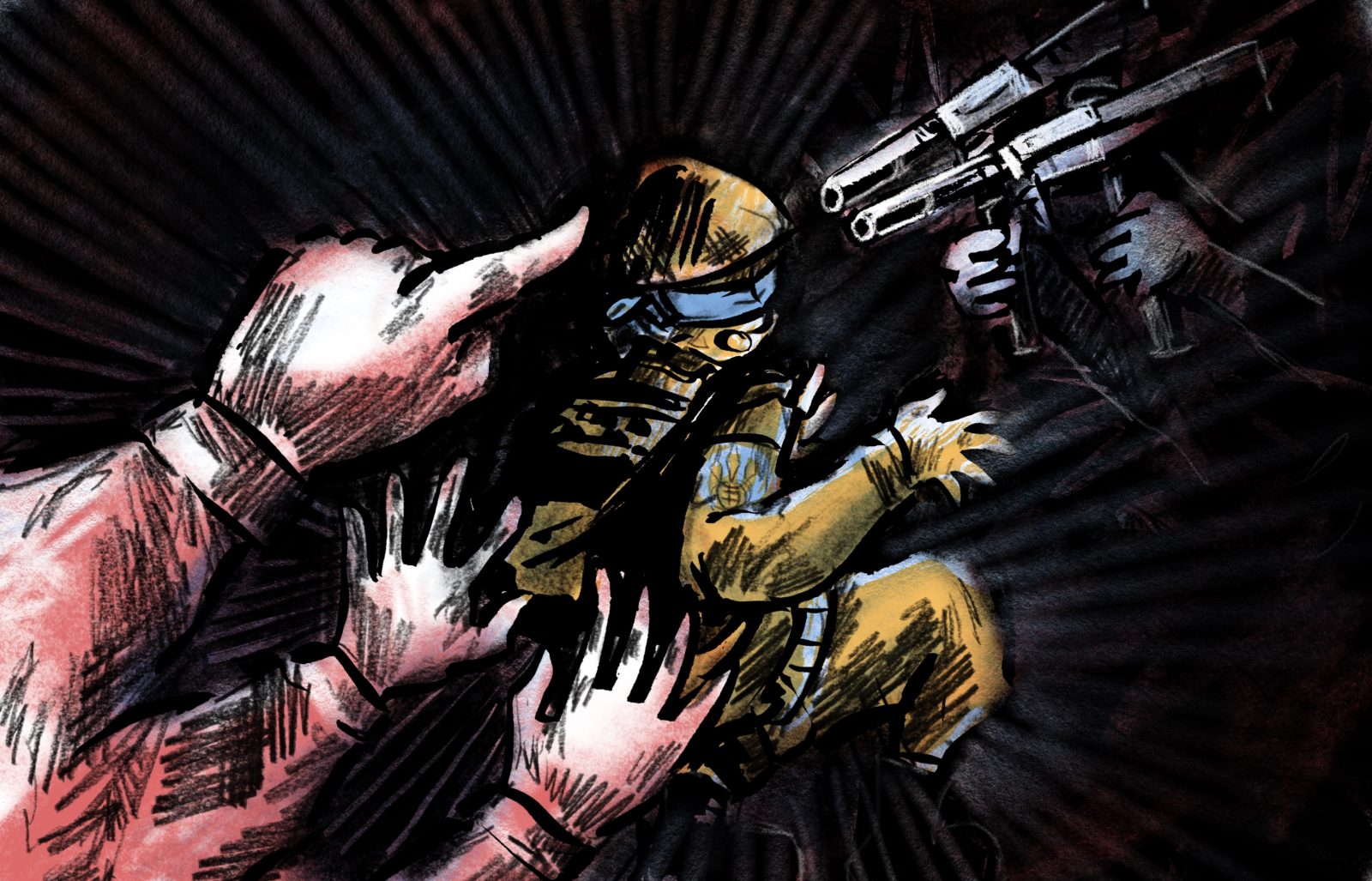
Fighters of the International Legion accuse some of their commanders of sending them on so-called suicide missions unprepared and with no information about the location of the friendly and enemy troops. (Illustration: Karolina Gulshani)
The Brazilian fighter started planning the operation in Sievierodonetsk, but neither Kuchynsky nor Taras Vashuk, the other commander, gave him any information – which he said they were supposed to – about the situation on the ground. By then, Sievierodonetsk was a center of heavy fighting. Ukrainian troops would retreat from the city a couple of weeks later.
“A lot of questions asked were not answered, like where friendly troops were,” the Brazilian officer said.
Only later did he learn that the previous group sent on this very mission came under friendly fire by Ukrainian soldiers. Another Brazilian legionnaire was killed and they had to retreat.
“We got into the field without knowing what was going on,” the officer said.
“I realized those motherf*ckers won’t let us plan,” he said of Sasha and Taras. “They would just bring us into the middle of the place, dump us there to fight, dump us there to die.”
Upon arrival, a Ukrainian special forces serviceman filled them in. He told the Brazilian that Ukrainian troops are inside the buildings along their way, but they have no established communication with them so they shoot at everyone who breaks through.
“What the f*ck? How are we gonna pass? These (Ukrainian) guys are gonna shoot at us?” the Brazilian said he asked.
“Yeah, that’s right. We need to hide,” the Ukrainian soldier reportedly told him.
They spent four days there instead of the planned two. They ran out of food and water and asked for rotation, but Kuchynsky, who sent them there, wouldn’t reply.
“Nobody slept, everybody’s super tired. Some of my guys are dehydrated, and one injured guy. And we stood there. That’s when Sasha (Kuchynsky) went off the radar,” he said.
Soon someone they didn’t know got in touch via radio saying a new group was on their way. The soldiers arrived but then left in the middle of the night without saying anything. The next day, another squad came in to replace them.
The Brazilian believes that Kuchynsky had no plan for their extraction.
“A bunch of wannabes, playing with people’s lives,” he said of the unit’s leadership. His account of suicide missions is confirmed by other soldiers – both in their conversations with the Kyiv Independent and in their official testimonies they filed to the President’s Office.
The Brazilian platoon leader and a couple of his soldiers got injured but survived. After finally getting evacuated from Sievierodonetsk, most of the squad fighters decided to quit the Legion.
“We’re not f*cking staying. We’re leaving,” the fighter recalled them saying.
The team of the Brazilian fighter is not the only one that left the Legion, disappointed.
Foreigners quitting the International Legion due to poor organization, lack of equipment, and indefinite contracts have already made headlines across international media.
Shopping mall plunder
Around the time of the Battle of Sievierodonetsk in early June, the legionnaires received a controversial task from Kuchynsky: to drive from their base to a local shopping mall in the front-line city of Lysychansk in Luhansk Oblast and take merchandise from the shops.
“I directly heard Sasha Kuchynsky’s order to the soldiers of my unit to break into the shopping center, collect the furniture and electronics as soon as possible and collect all possible valuables along the way,” a Canadian fighter wrote in his statement following the incident.
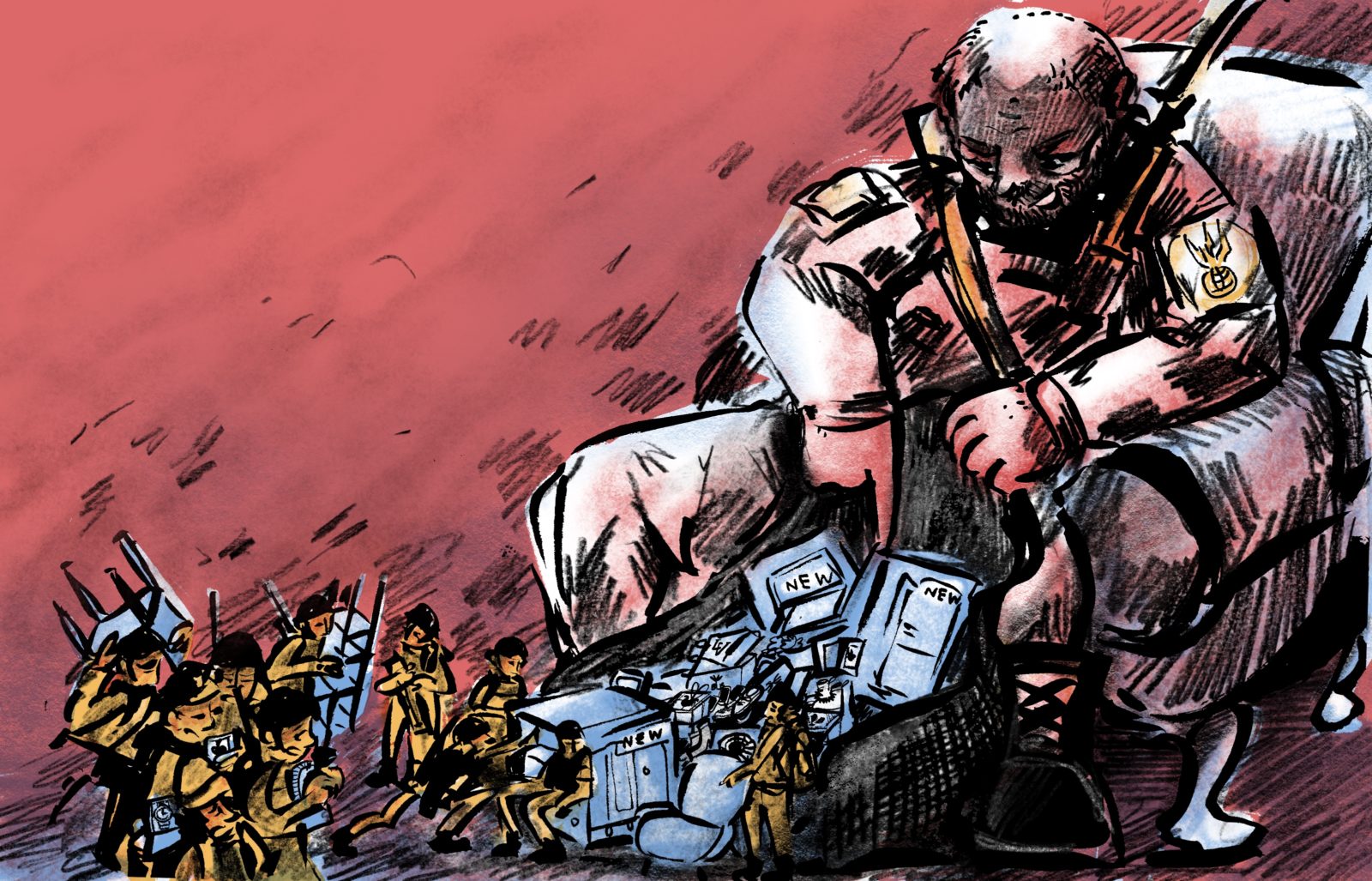
Fighters of the International Legion accuse some commanders of giving them orders to loot a shopping mall. (Illustration: Karolina Gulshani)
According to the soldiers’ official testimonies obtained by the Kyiv Independent, “Sasha” also told subordinates to take whatever they liked: shoes, women’s clothes, jewelry, watches, and electronics.
Many soldiers obeyed as they come from professional military backgrounds where they don’t question superiors’ commands.
“(Normally) you should say ‘yes, sir’ and get it done. Because you believe that your commander knows what he’s asking you to do…You just assume that this action is legal, and you’re going to go for it. You’re not supposed to question it,” the Brazilian legionnaire told the Kyiv Independent.
“Locals saw how we loaded the furniture which made me very uncomfortable. It felt like we were robbing them. I didn’t come to Ukraine for this,” a testimony of a Columbian soldier reads.
“There were local residents near the shopping mall, one of whom, seeing this, shouted insults, and the others looked at us with reproach and condemnation. I don’t know whether it was legal or not but I felt ashamed to carry out the order of Sasha Kuchynsky and take away furniture and valuables from stores during hostilities and in front of local residents who suffered from the war,” a French legionnaire wrote in his statement.
Some soldiers refused to follow the order.
In a video obtained by the Kyiv Independent, some foreigners can be heard in the shopping mall questioning the legality of “Sasha’s” orders.
“We will not be implicated by any means as looters. We will not stand for this,” an English-speaking soldier is heard saying.
He then tells the crowd that he will not stay in front of the stolen goods and is going downstairs to wait until the car picks him up and drives back to the base. “Sasha” becomes angry at the soldiers’ refusal to carry out his orders.
“Listen, (do not set) conditions for me. This is an order, to stay here and wait for the commander. This is an order. You get it? An order. This is the army,” the Polish commander says in broken Russian.
“I do not find that order lawful. We do not see this as reasonable,” the soldier replies.
The video ends with the soldier saying to his peers: “Let’s go downstairs, guys. We are not playing these games.”
According to the legionnaires, Kuchynsky ordered similar lootings on multiple occasions and Ukrainian soldiers were ordered to participate as well.
The legionnaires don’t know where the items were sent to. In a video obtained by the Kyiv Independent, one soldier is heard saying in Russian that the furniture and electronics taken from the mall were for their unit’s headquarters in Kyiv.
Theft allegations
According to the legionnaires, they regularly witnessed what they believe were suspicious arms movements.
“The car is coming, the cars going, the boxes of weapons coming, the boxes of weapons going,” one of the American soldiers said.
Despite the legion’s armory rooms being loaded with all sorts of heavy weaponry and ammunition, the soldiers say they often didn’t end up in their hands.
“During my stay in Sievierodonetsk, a civilian vehicle painted in camouflage containing thermal imagers arrived,” a Columbian soldier wrote in his testimony. “They were not distributed among the soldiers due to their alleged absence. Meanwhile, Sasha Kuchynsky proposed to the military personnel of the International Legion to buy these thermal imagers for $300.”
“I think, Sasha Kuchynsky artificially created the impression of a shortage of some ammunition to illegally enrich himself by providing it to fighters (for money) as if from himself,“ another fighter from Columbia wrote in his testimony.
According to him, two of his fellow soldiers damaged their hearing due to the lack of headphones that he knew were in their armory, under Kuchynsky’s control.
Soldiers say Kuchynsky would take away part of the ammunition they would independently receive from volunteers and donors. They called it the “Sasha tax.”
“So you have to give Sasha what he wants. And then you can give (the rest) of this stuff to your guys,” one of the American soldiers said. “Everything just seems like a cover-up. It’s very strange. It feels like an (organized) business.”
The same happened to another American soldier. His shipment arrived at the base while he was on a mission. When he returned, some parcels were gone.
“It was labeled for our team. So basically, simple as that, half of the stuff wasn’t there.”
Waiting for solution
The foreign soldiers say they did not want to publicize the crisis in the International Legion and tried to solve the issue behind the scenes.
They first complained to their commanders, then lawmakers, and finally went as far as the President’s Office. Since the Legion was created upon Zelensky’s order, foreign fighters counted on his administration’s support, but did not get much help from there, they said.
Alyona Verbytska, the president’s commissioner for soldiers’ rights, told the Kyiv Independent she had informed her superiors about the legionnaires’ complaints. She did not elaborate on who exactly she reported to.
In the President’s Office, two people oversee the Legion for Zelensky, according to the Kyiv Independent’s sources close to the Office. They are Vitaliy Martyniuk, a national security expert, and Roman Mashovets, deputy head of the Office and former employee of the GUR intelligence agency.
The President’s Office did not reply to the Kyiv Independent’s request for comment before publication.
Complaining to the President’s Office didn’t work out. Things even got worse, the soldiers said, as those who sounded an alarm about the Legion’s leadership started to feel under pressure and receive threats.
Meanwhile, many professional members left the unit due to alleged mismanagement and problems with paperwork. The Legion failed to provide some of them with official contracts.
“There were really good special (forces) guys. I mean, not from the regular military. A lot of special (forces) guys literally just said: ‘No, thank you. We can’t work like that anymore’,” an American soldier said.
Those who stayed in the unit want it to keep helping Ukraine to stand against Russia. To do it effectively, they believe, the Legion must be reformed under new leadership.
“I have a very, very, very pleasant experience with everybody in the Ukrainian military outside of Sasha and Tarases,” one of the American soldiers said.
“I’ve always just kind of kept my mouth shut. Just because people like Sasha really discredit all of this,” he said.
Note from the authors:
Hi, it’s Anna and Alexander here. We worked hard to piece the evidence together and break this story. We believe it is crucial to shed light on mismanagement in the army, especially in times of war. We wanted to help bring change to the International Legion so it continues to assist Ukraine in defending itself against Russian aggression. Now, however, many legionnaires are resigning due to the commanders’ misconduct.

